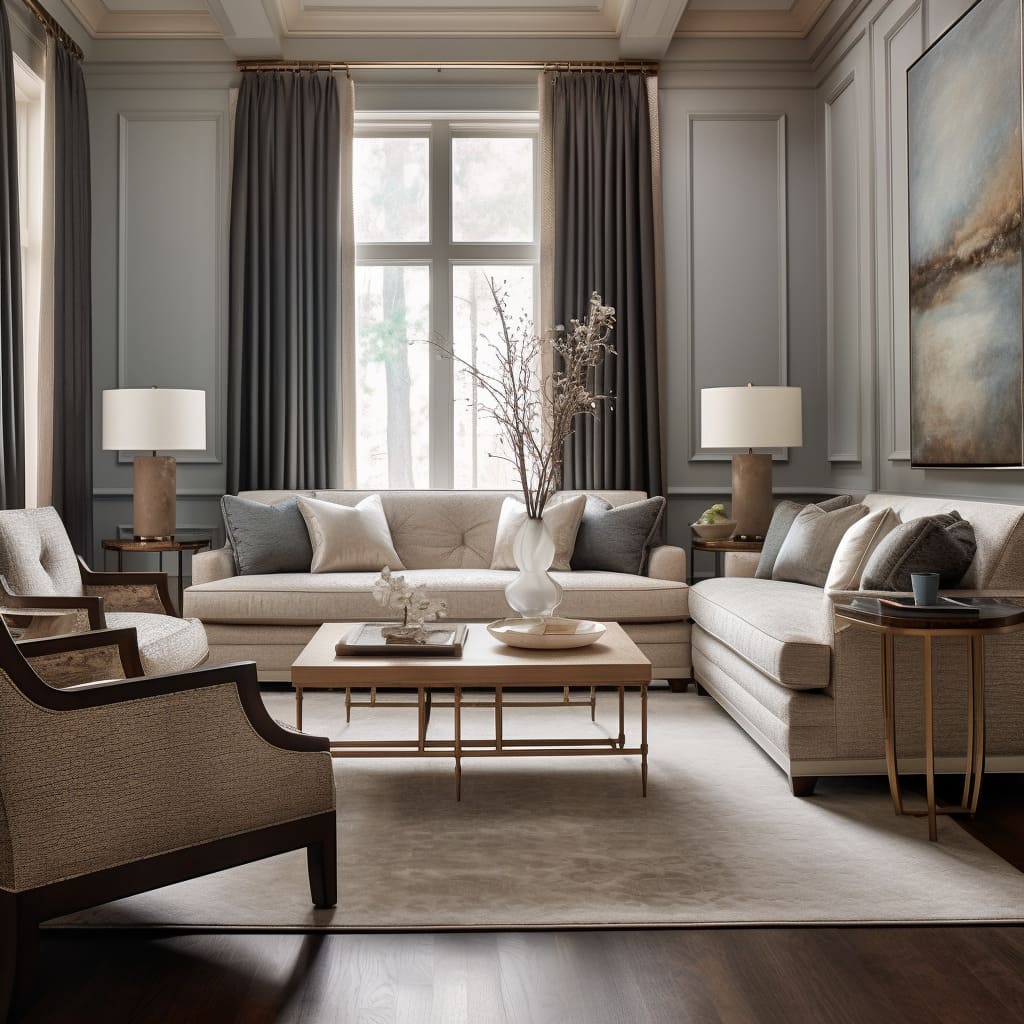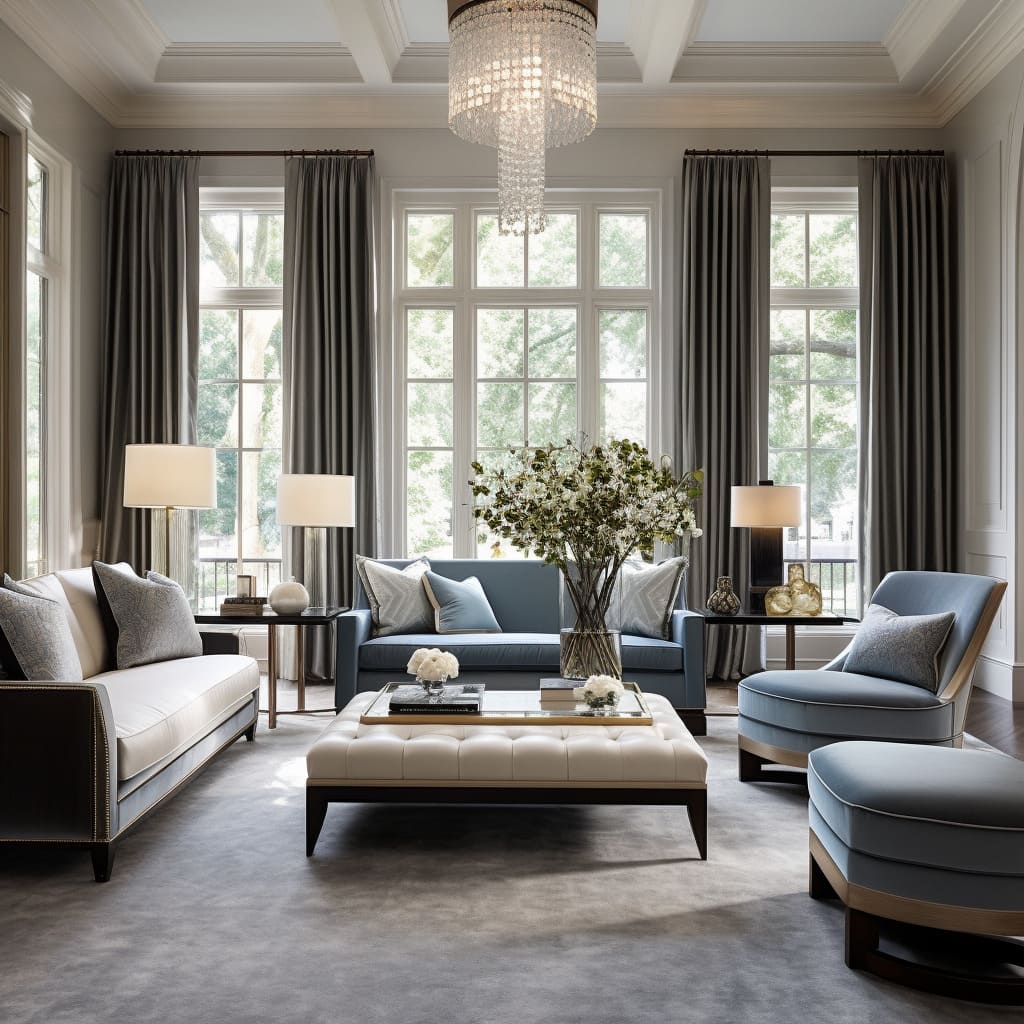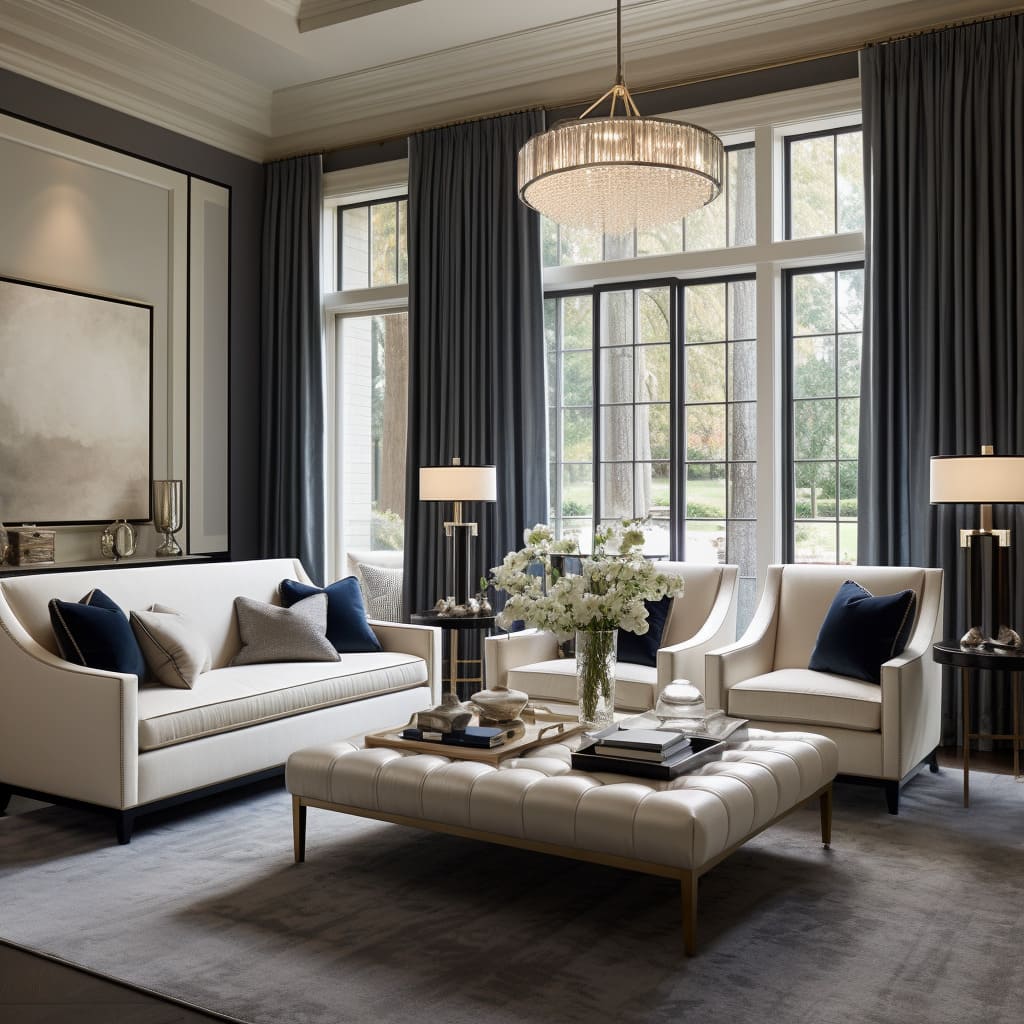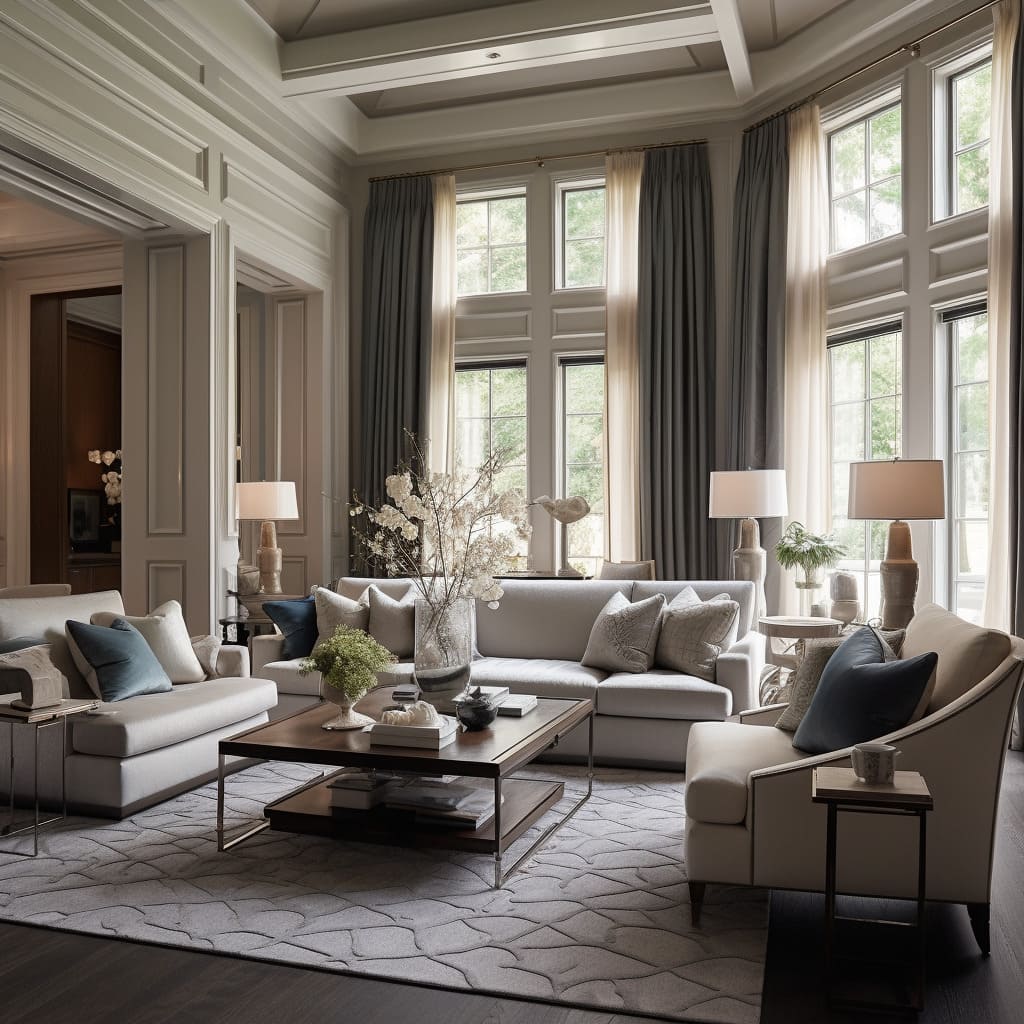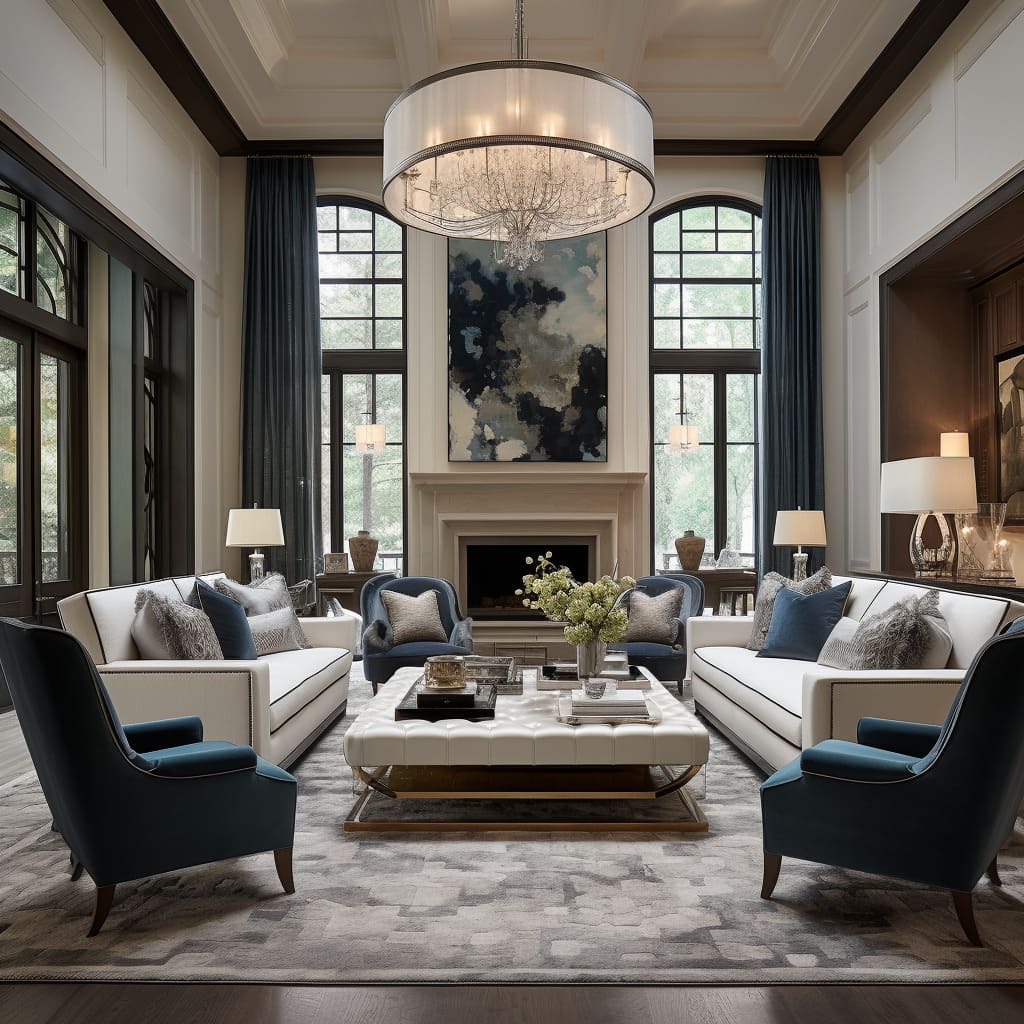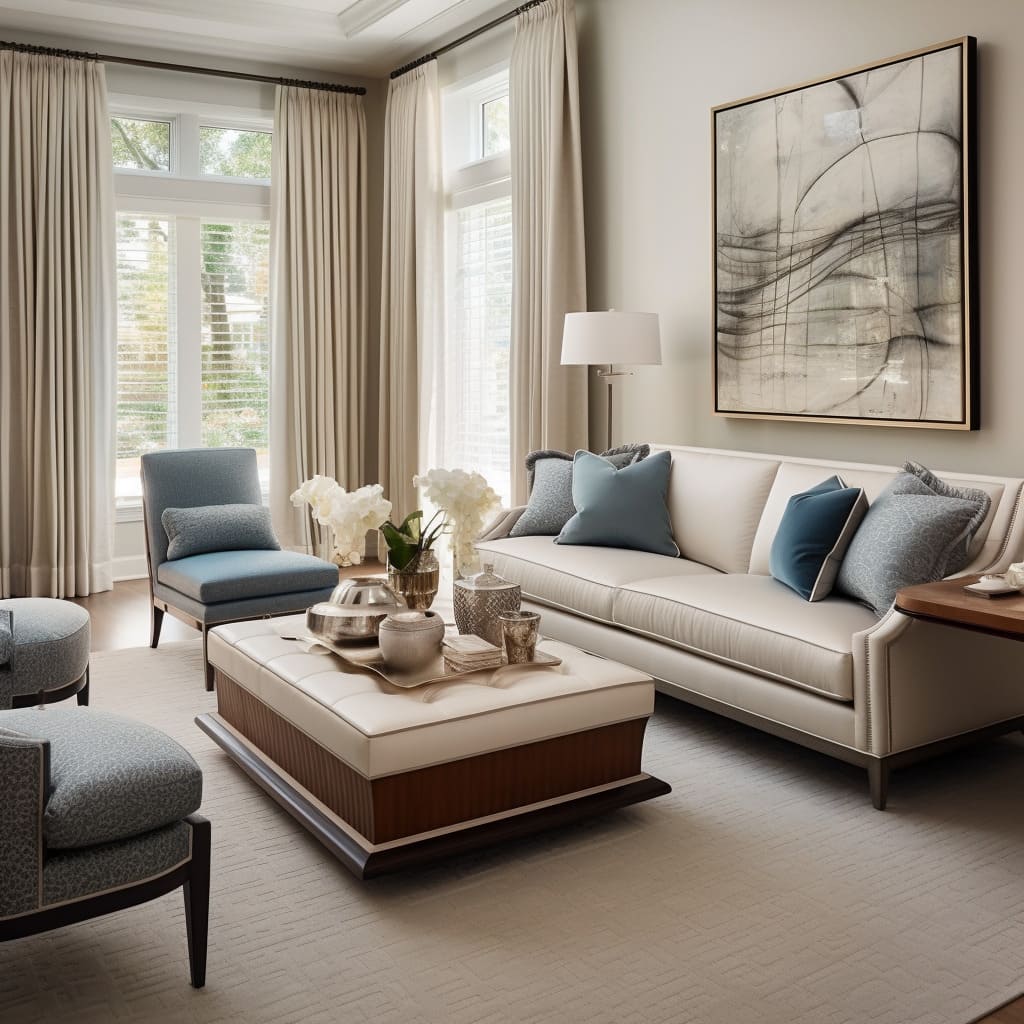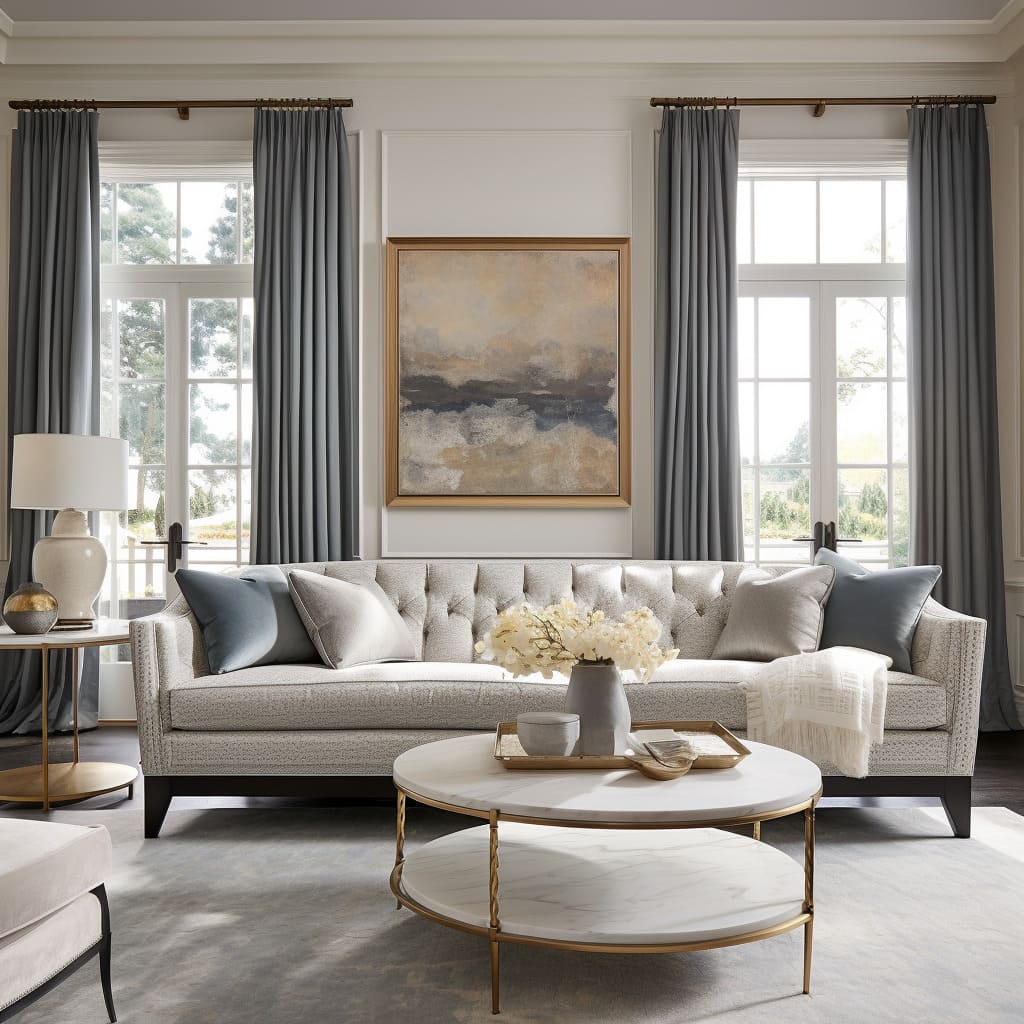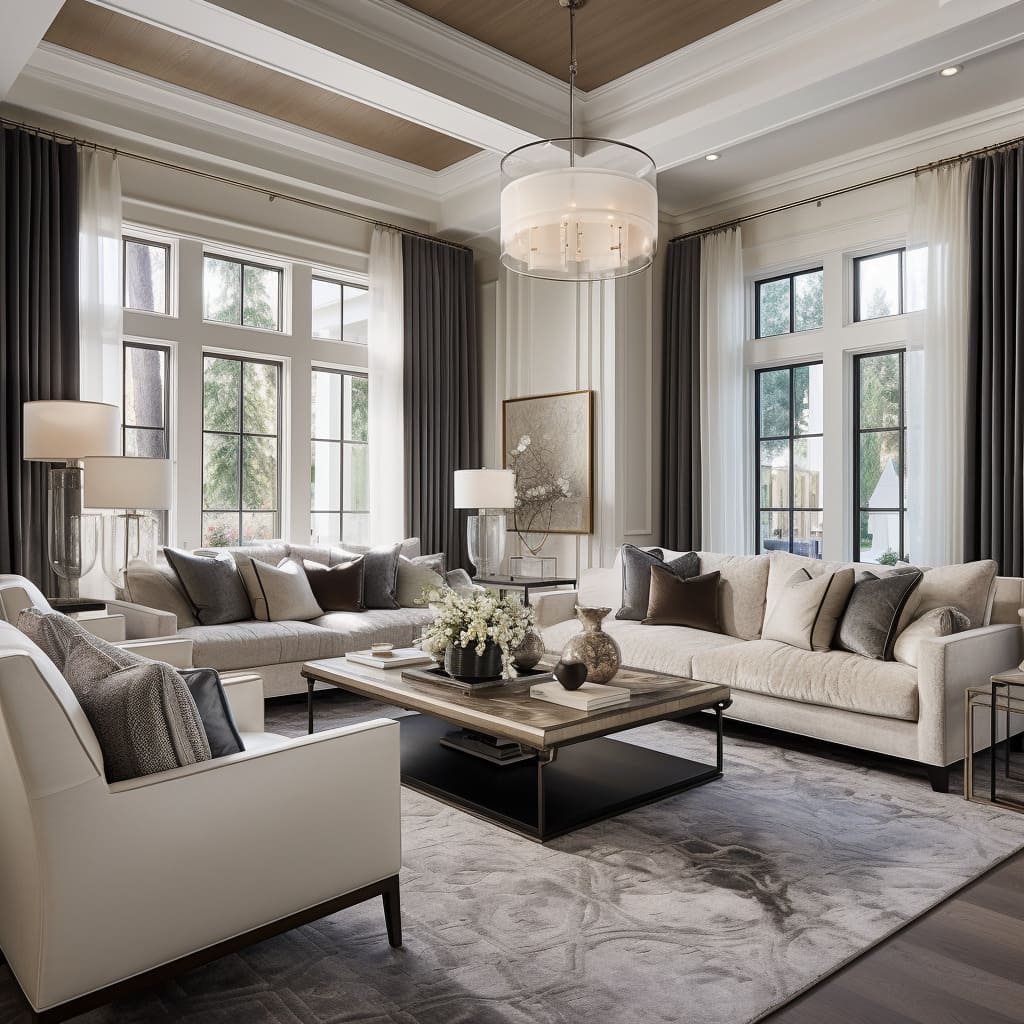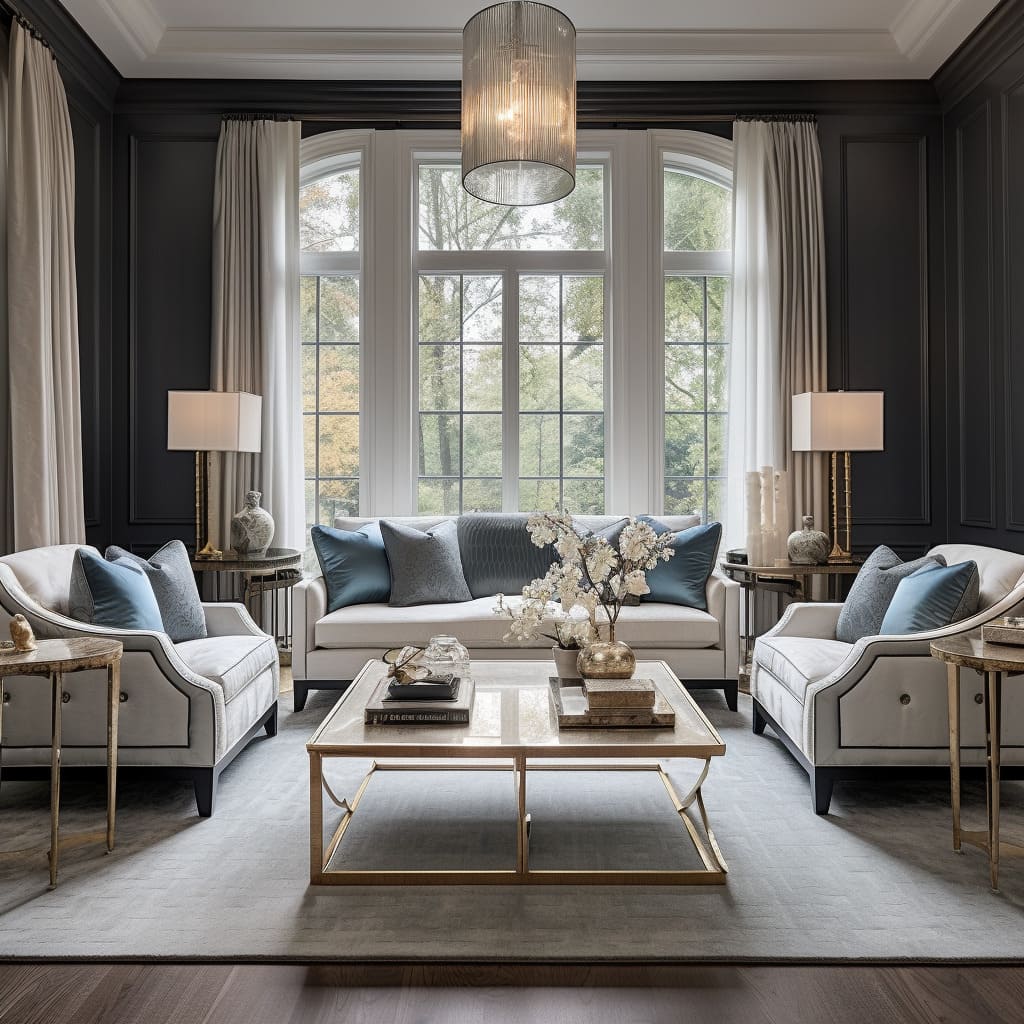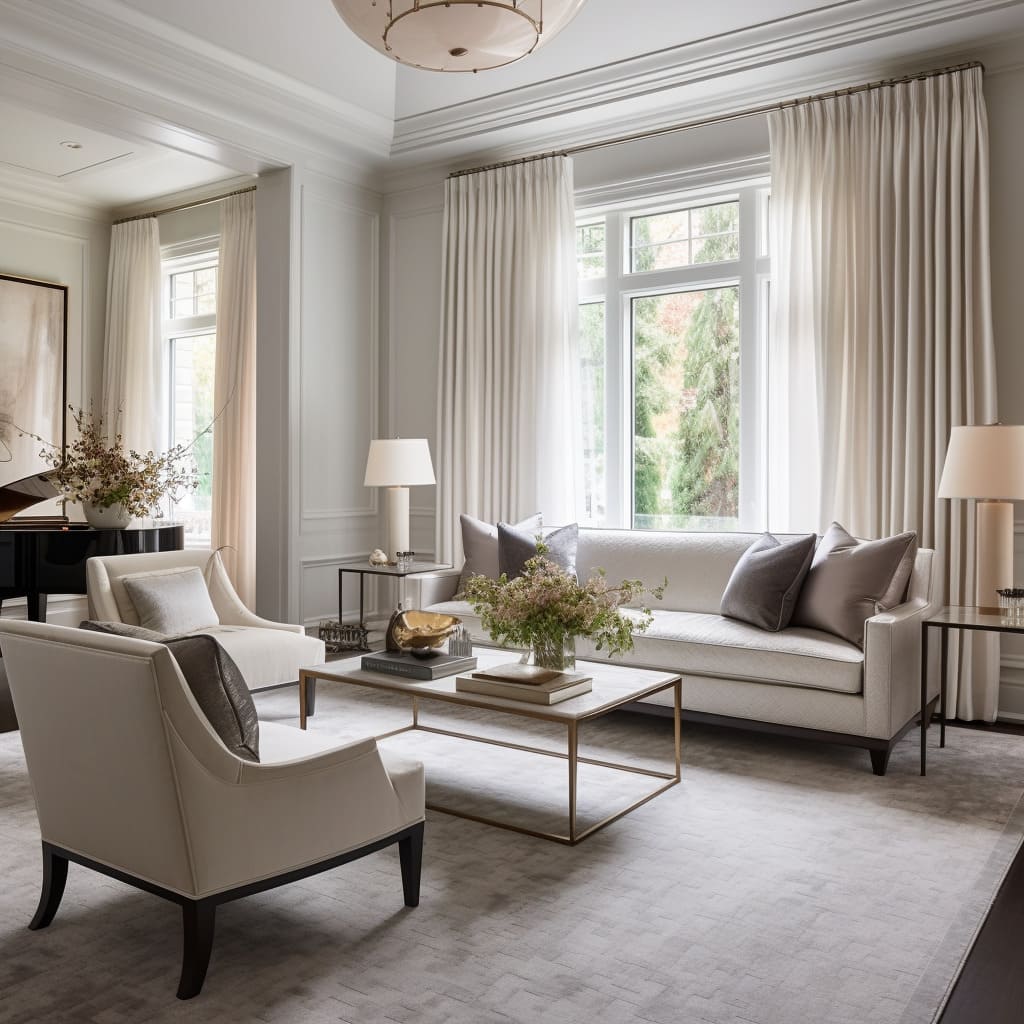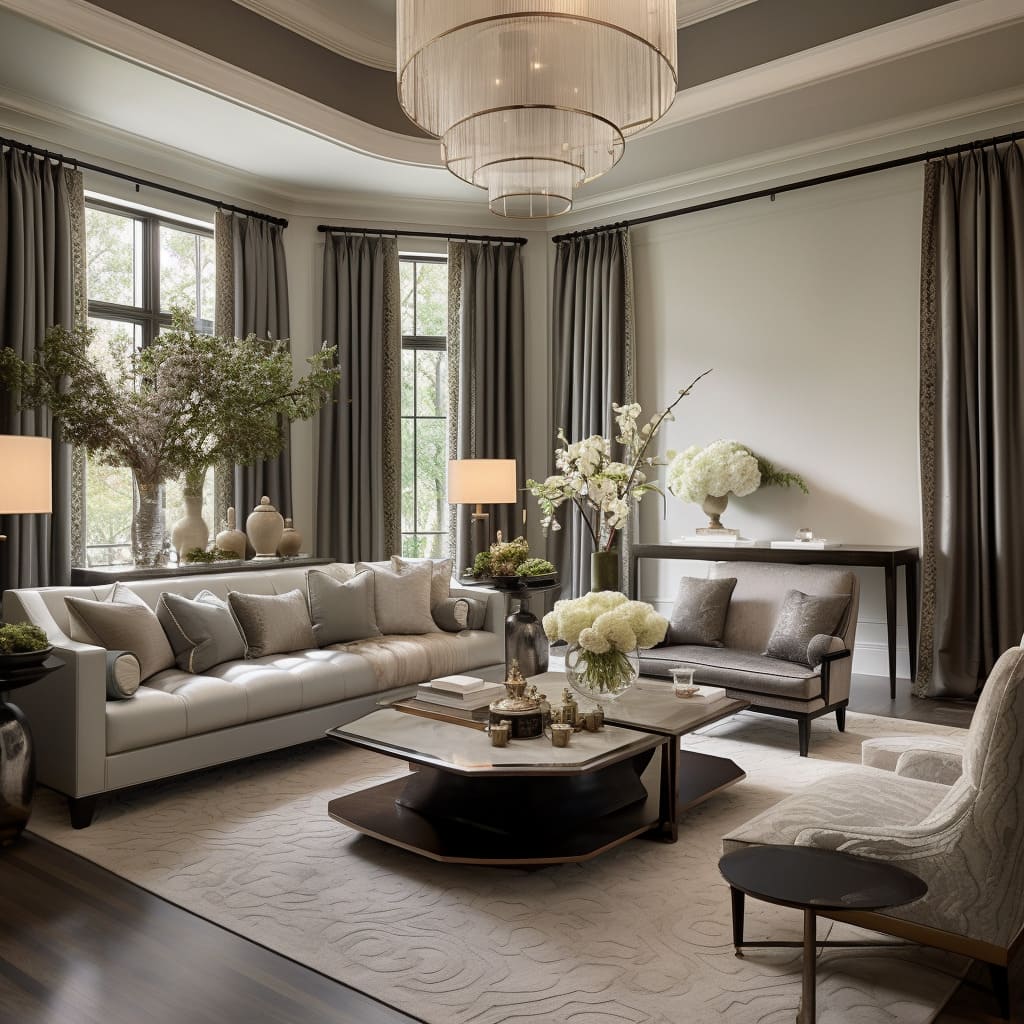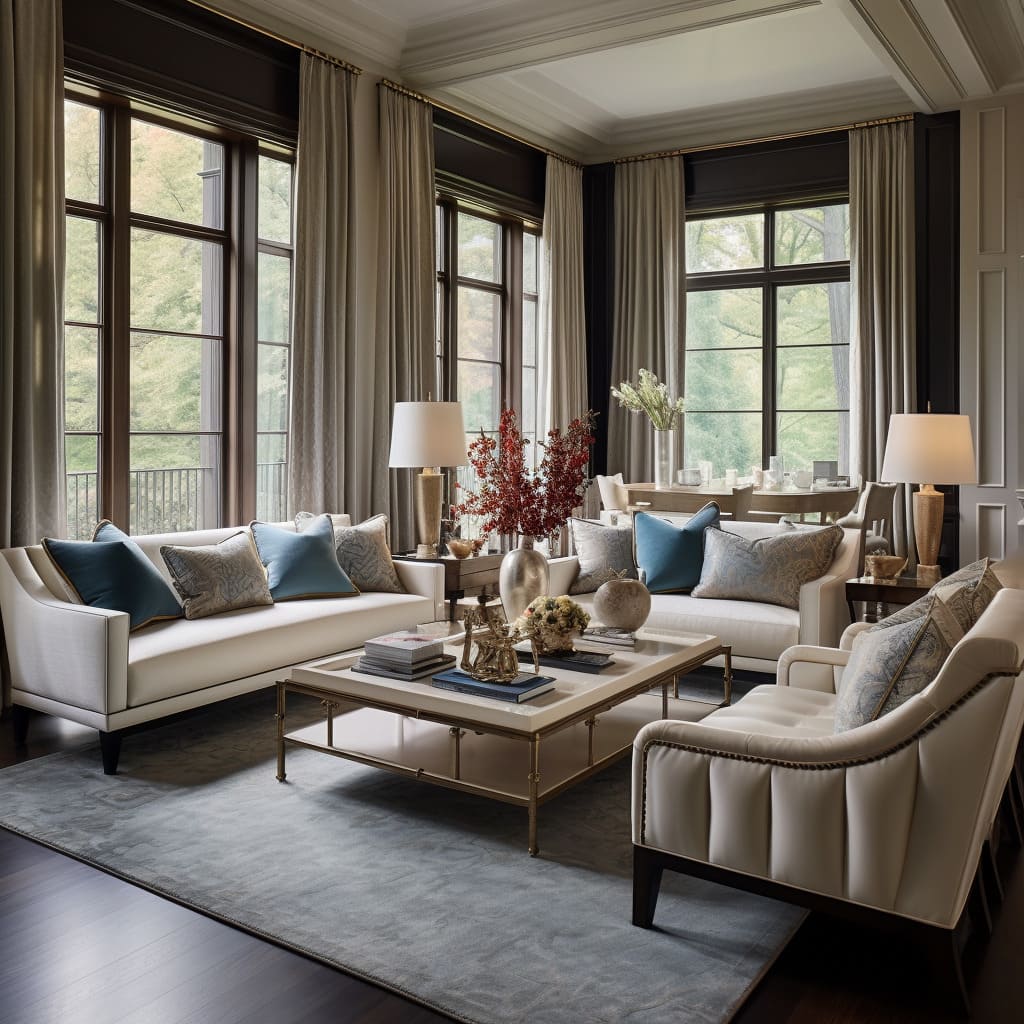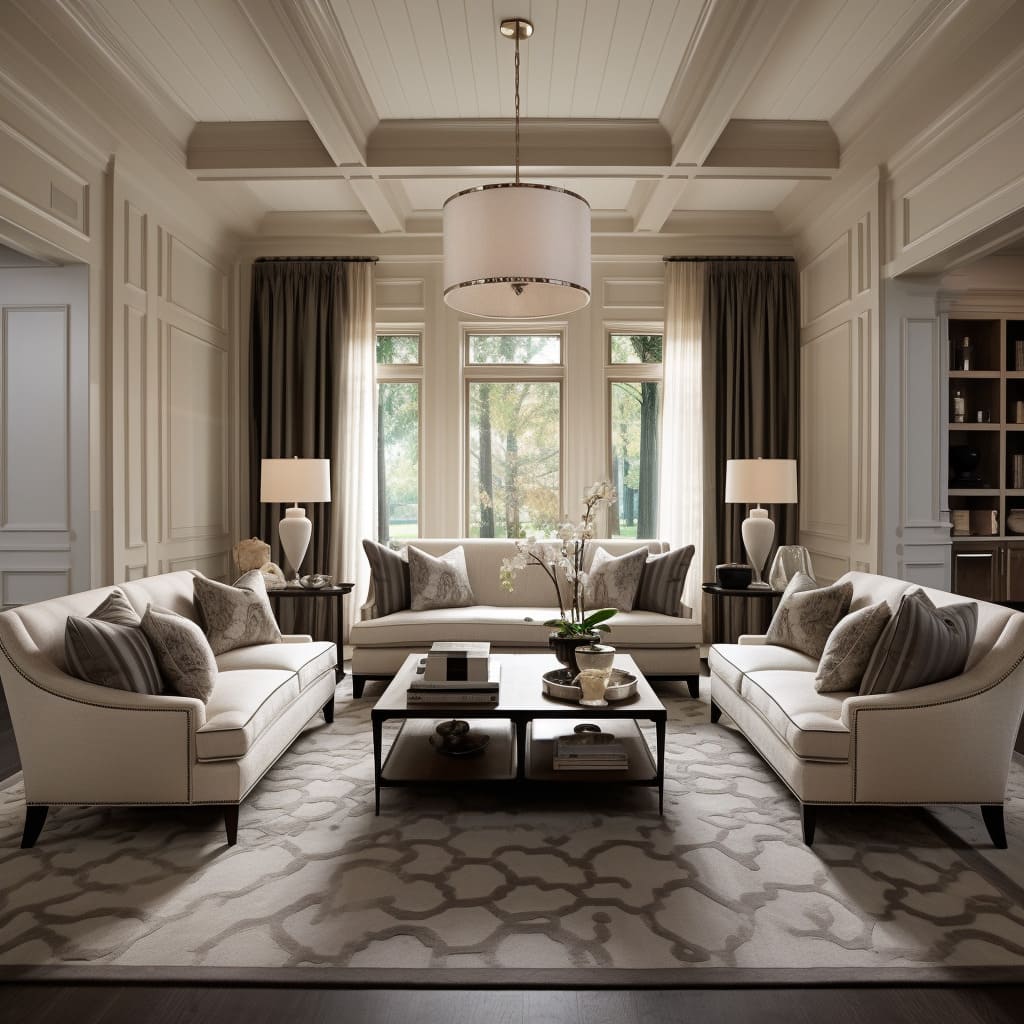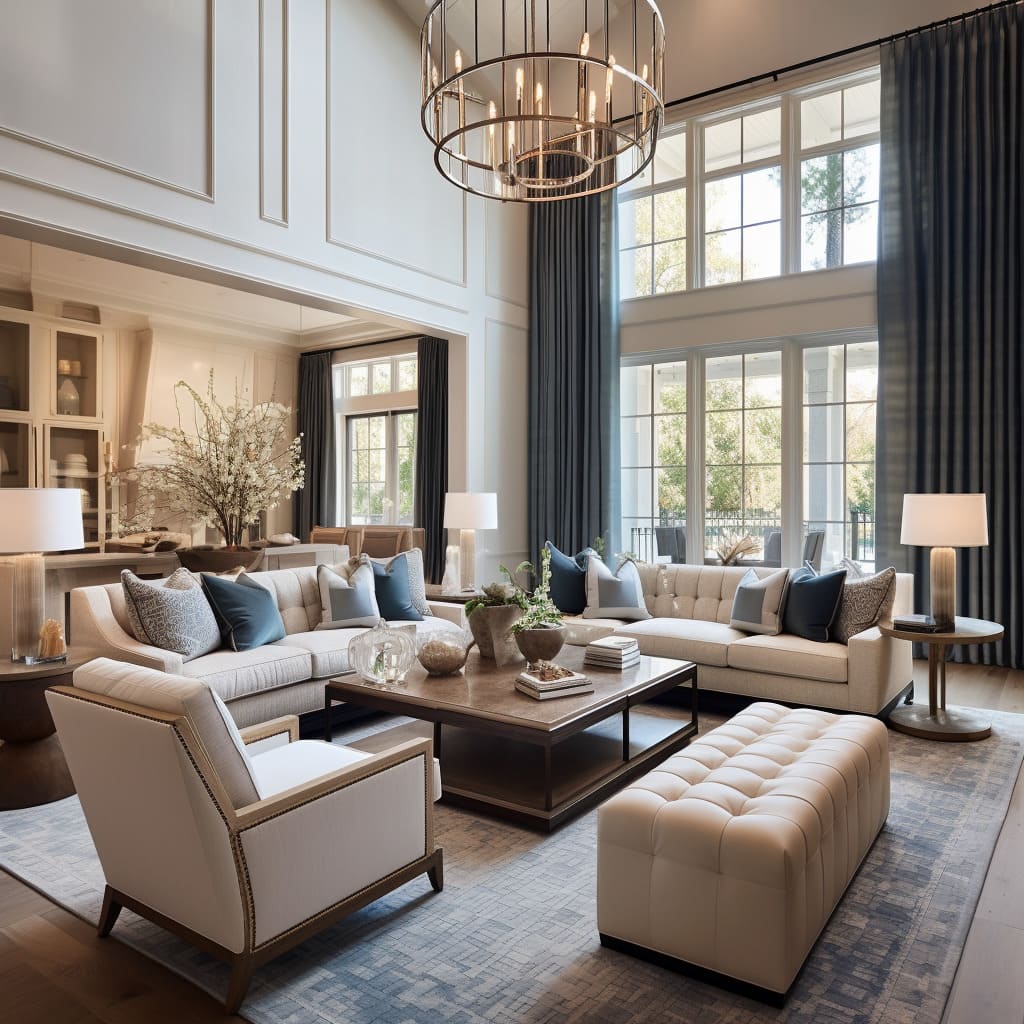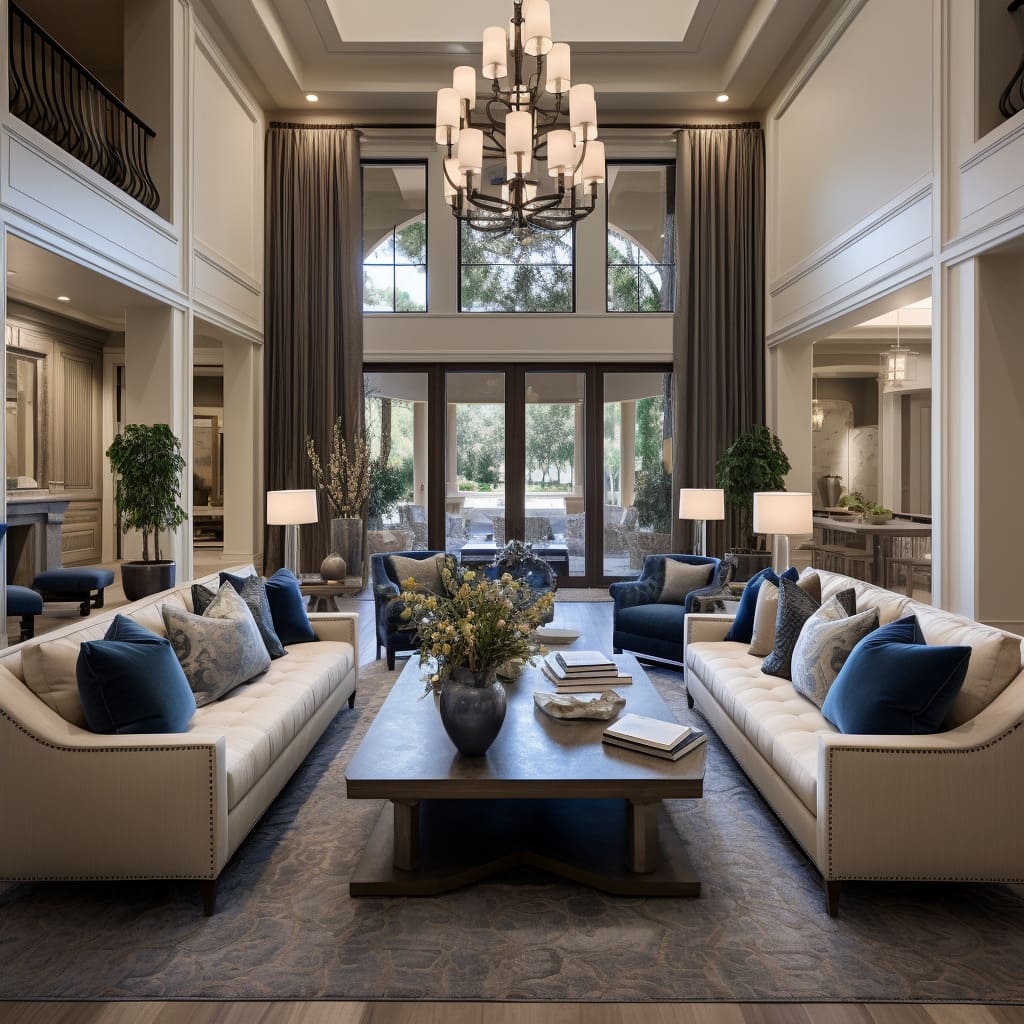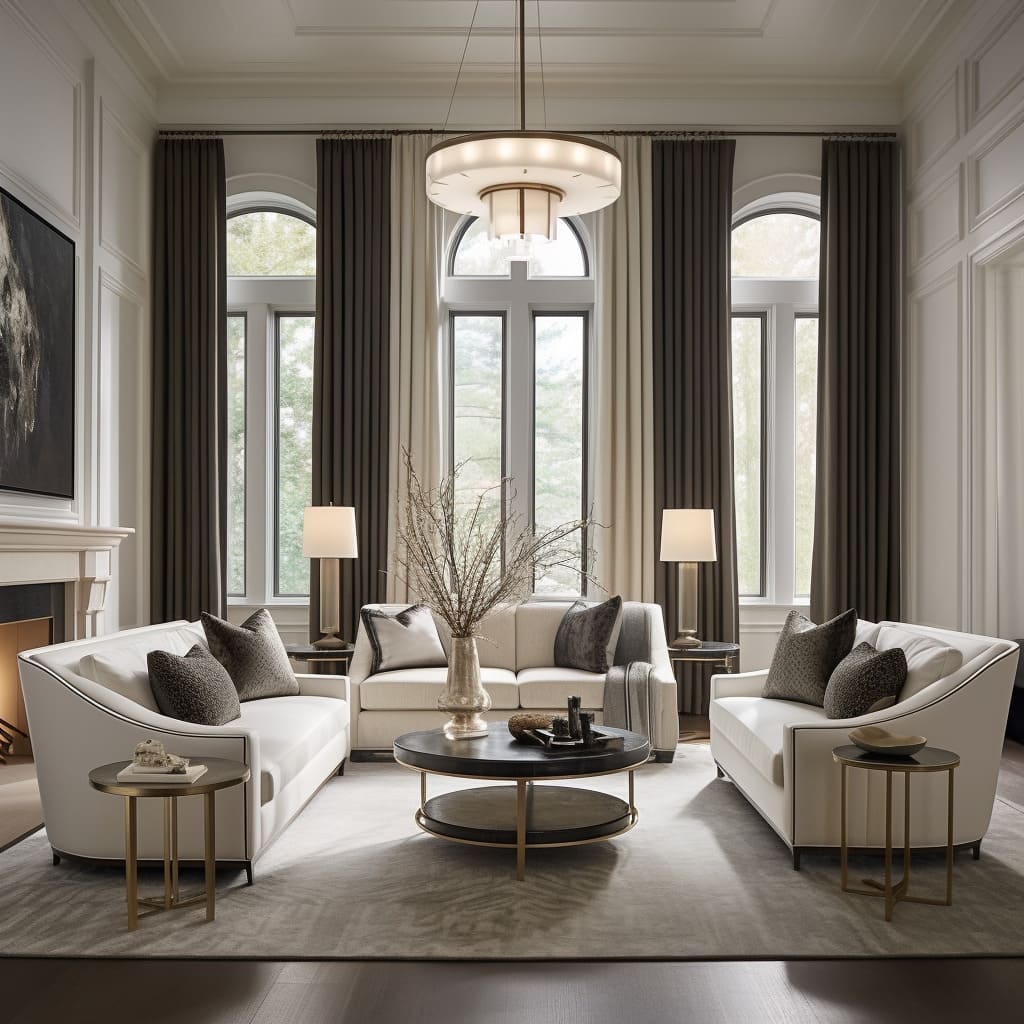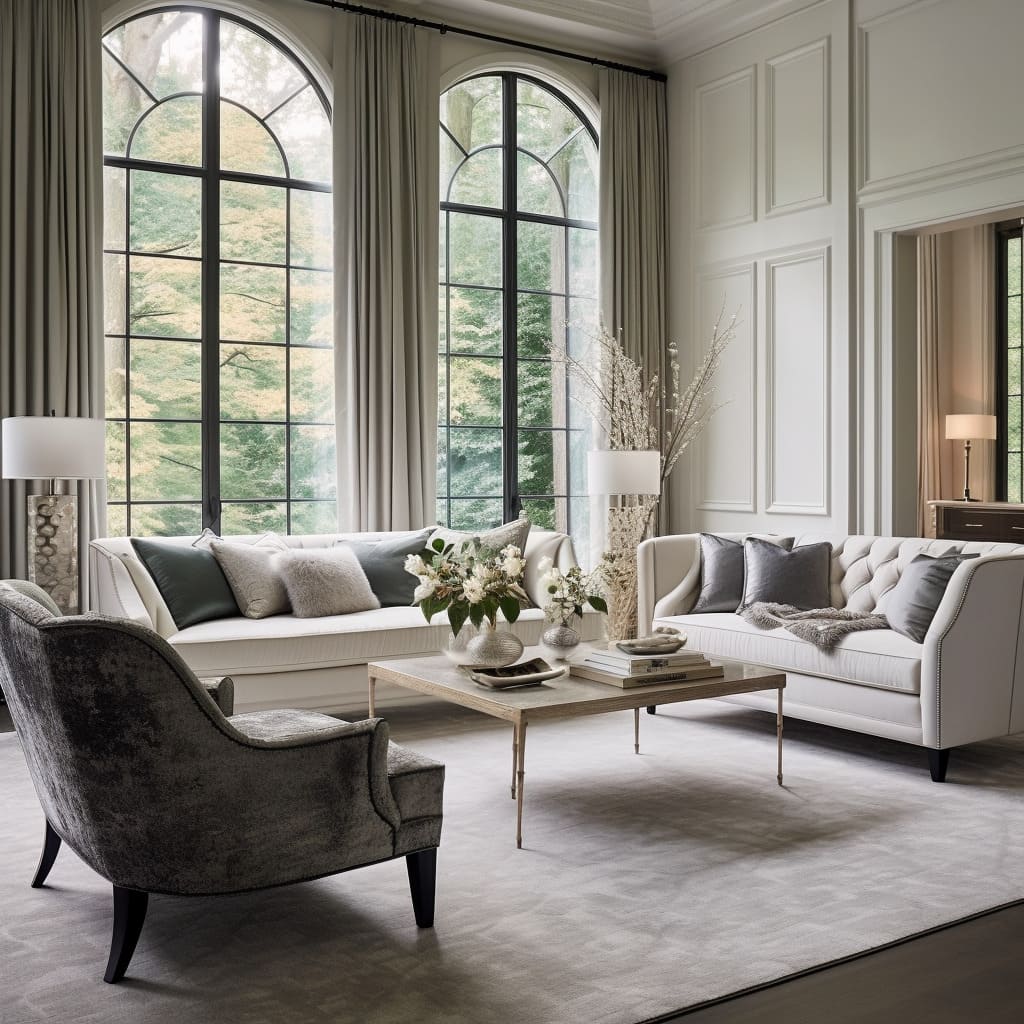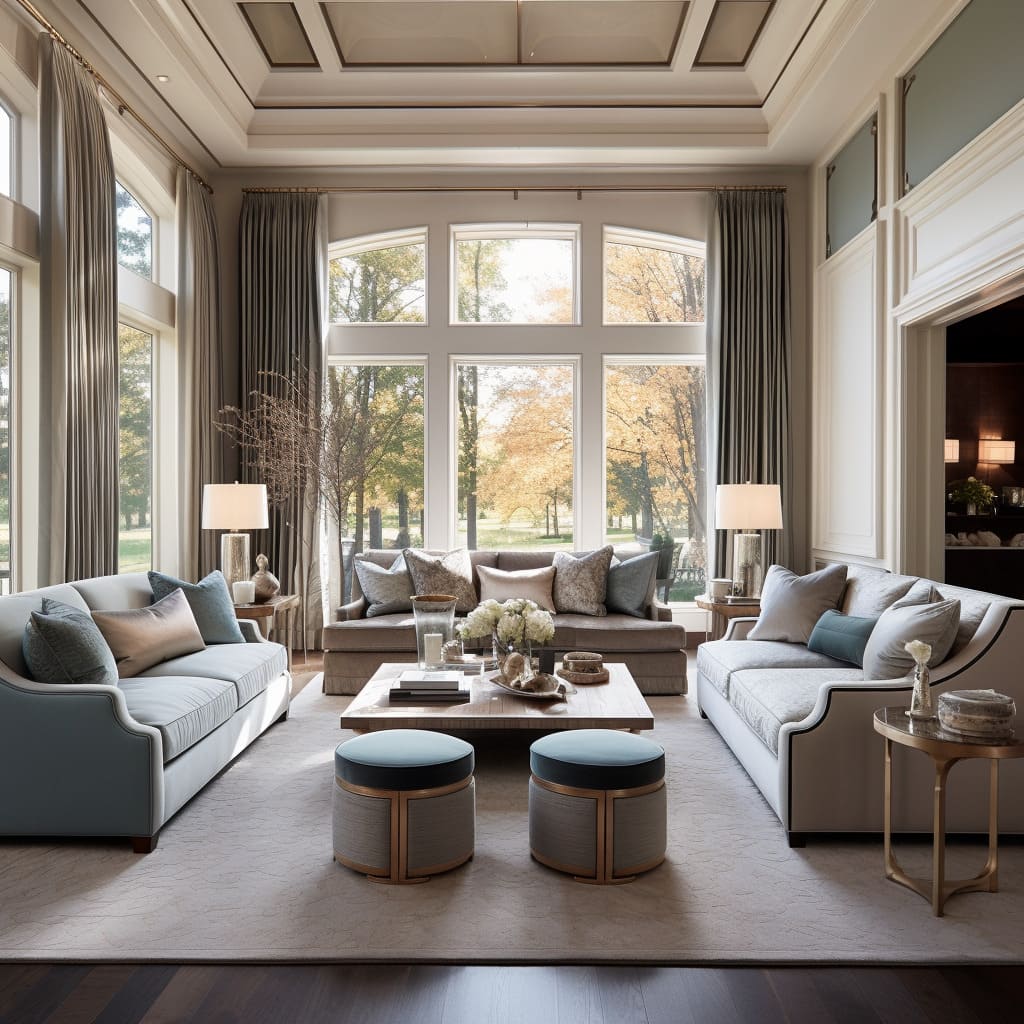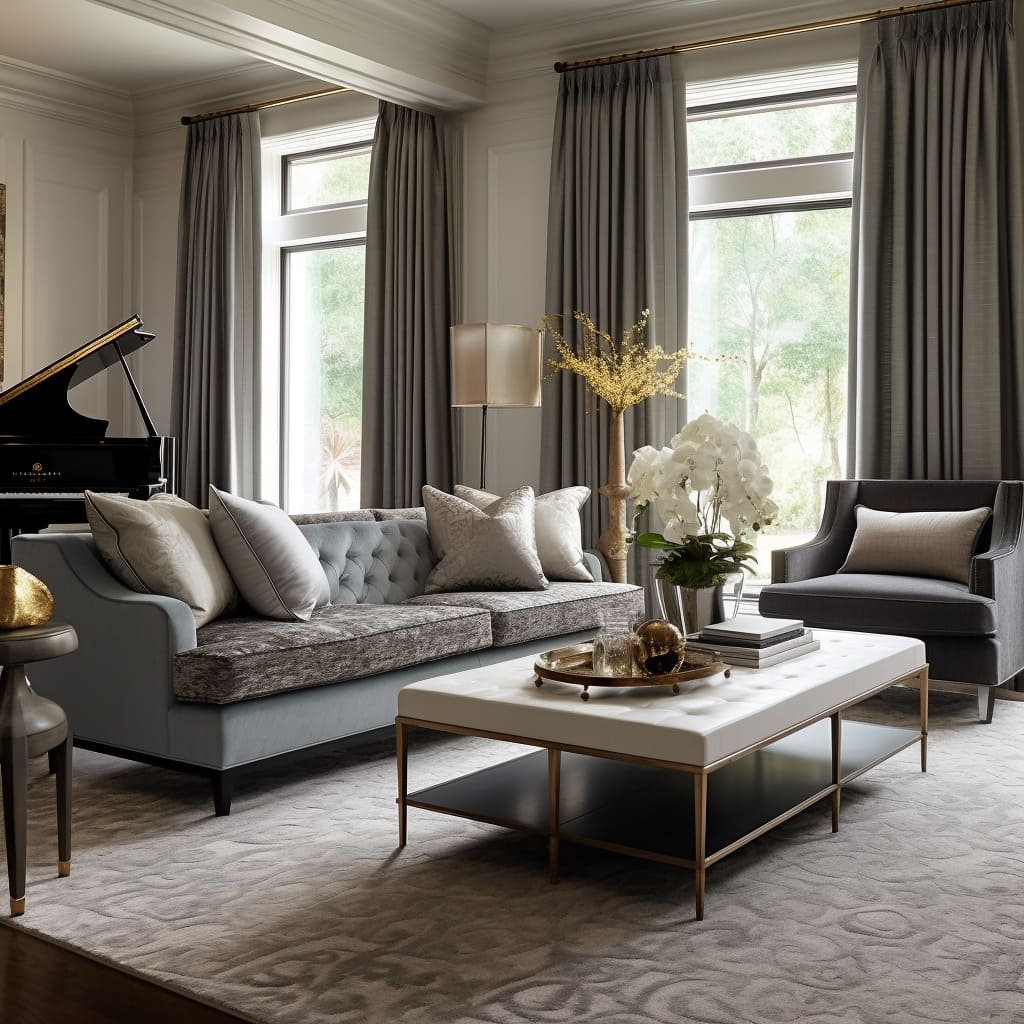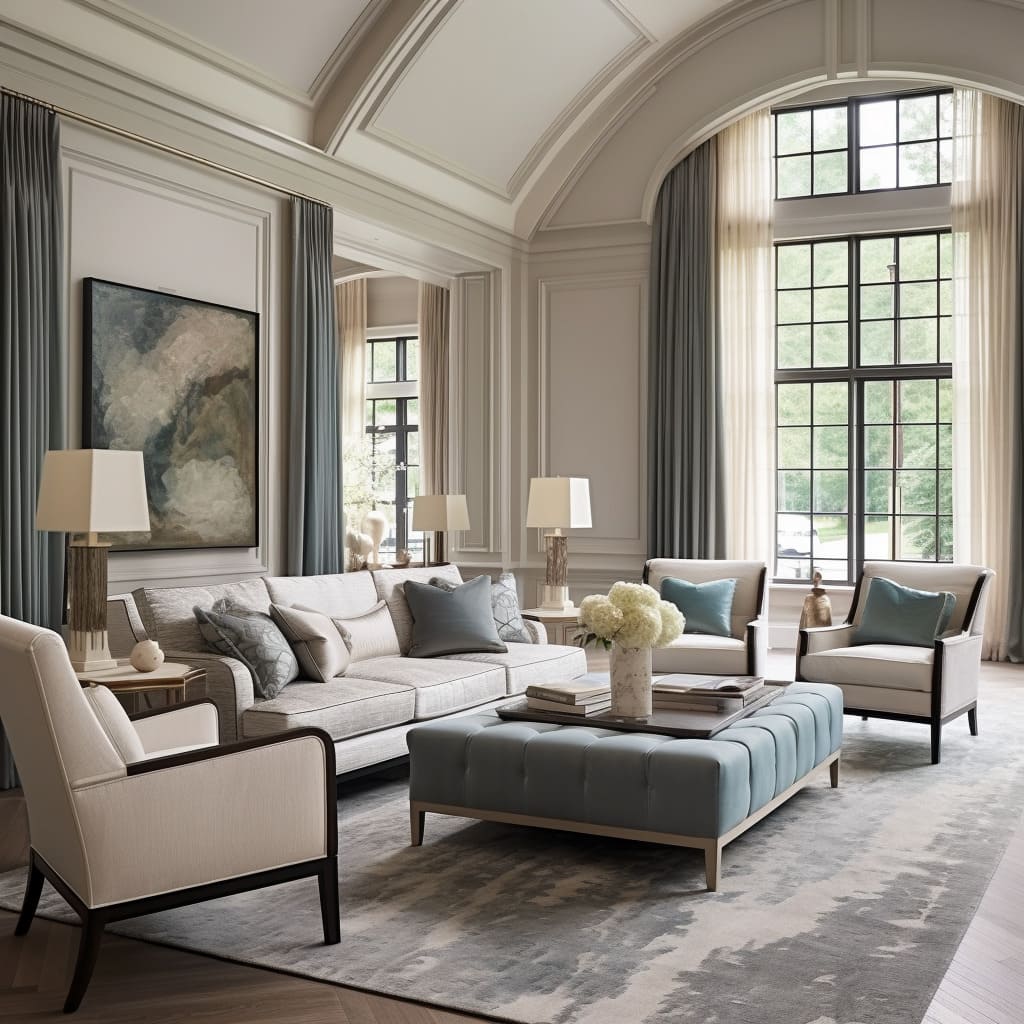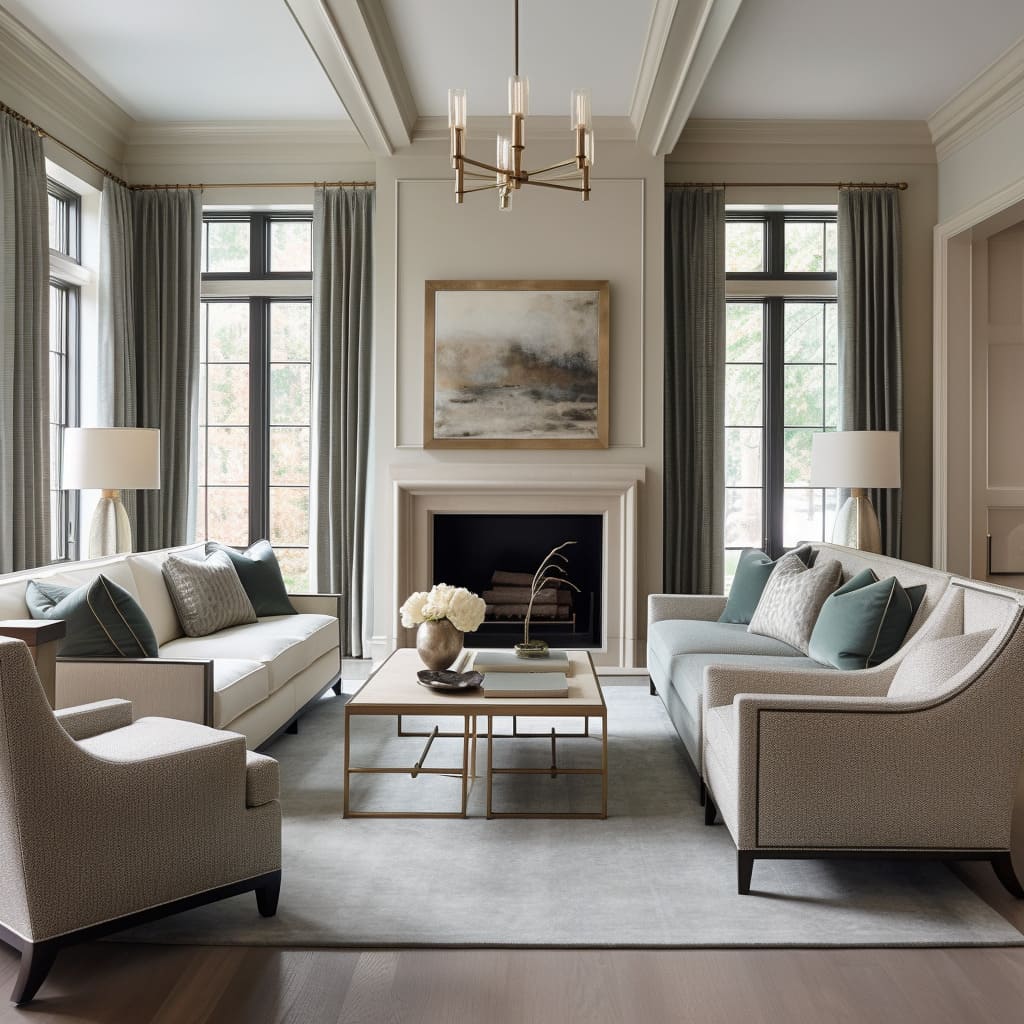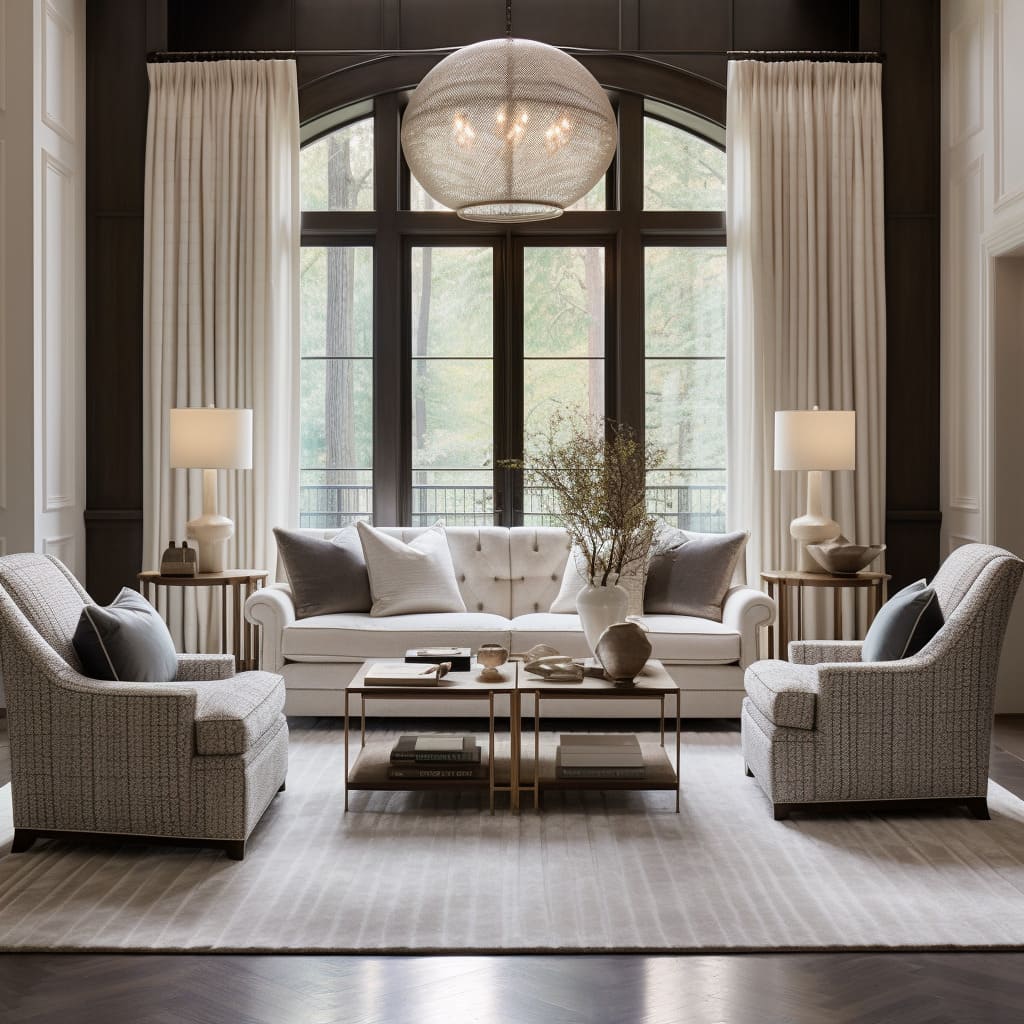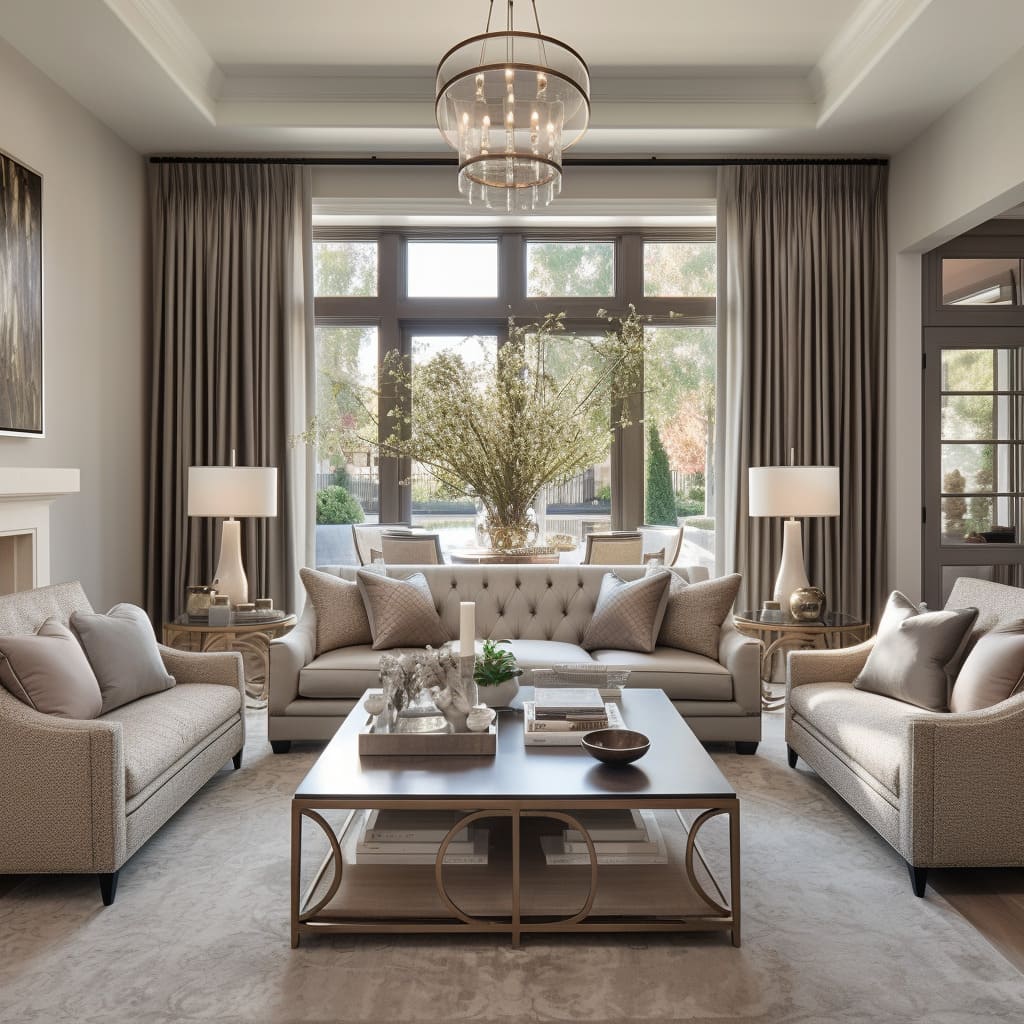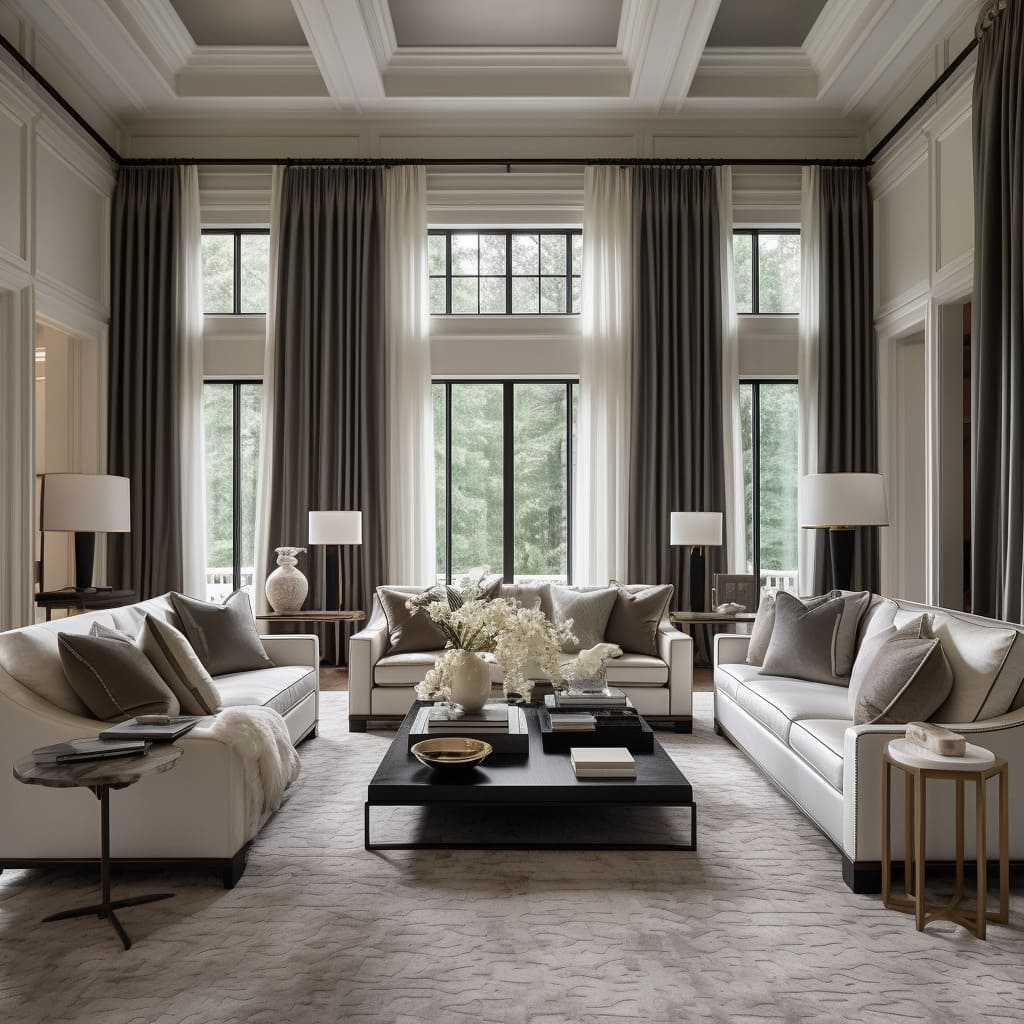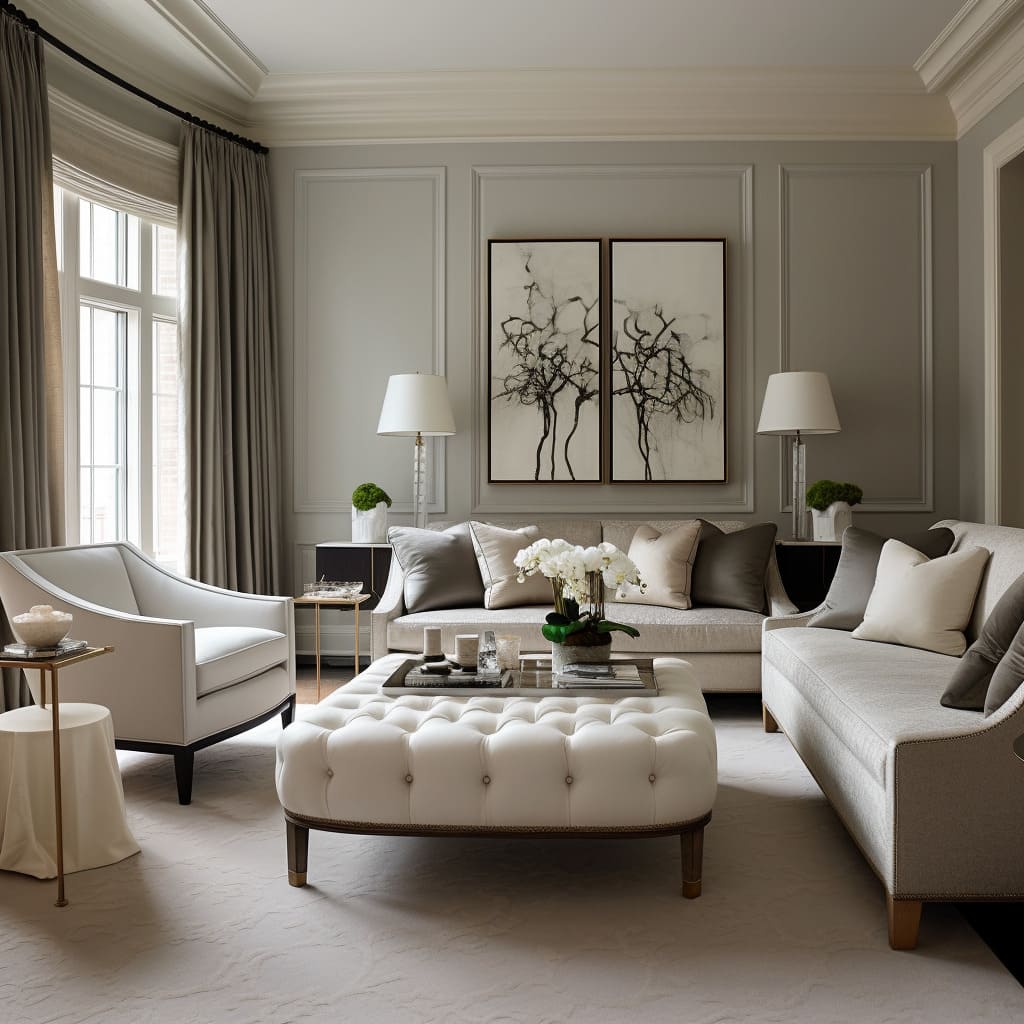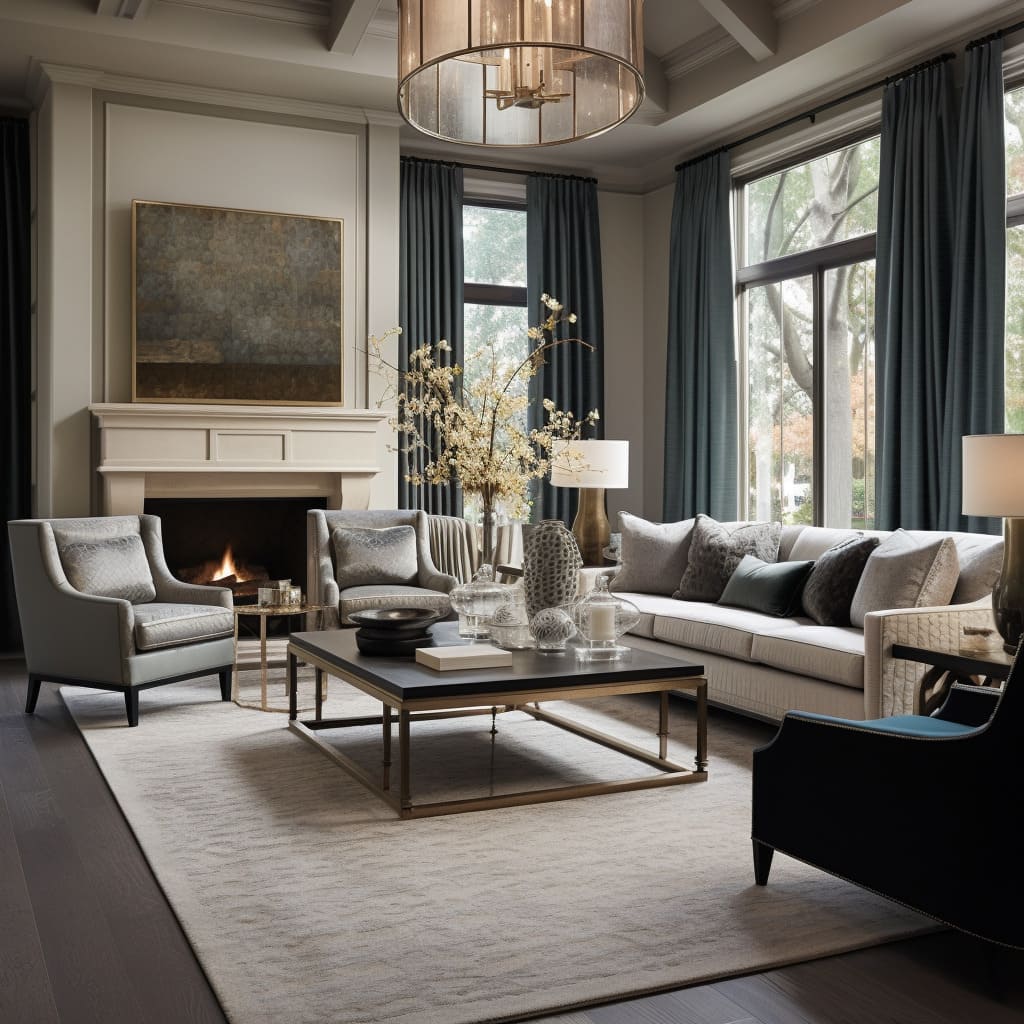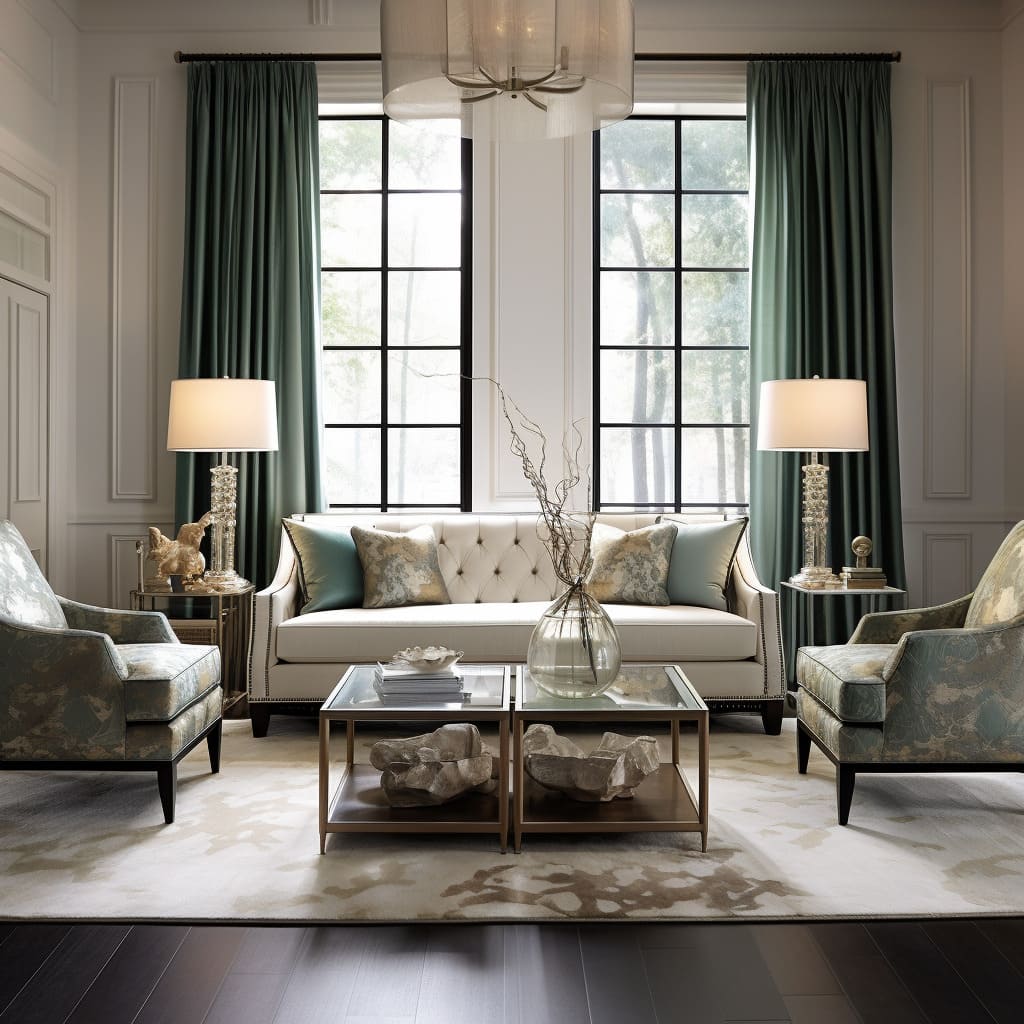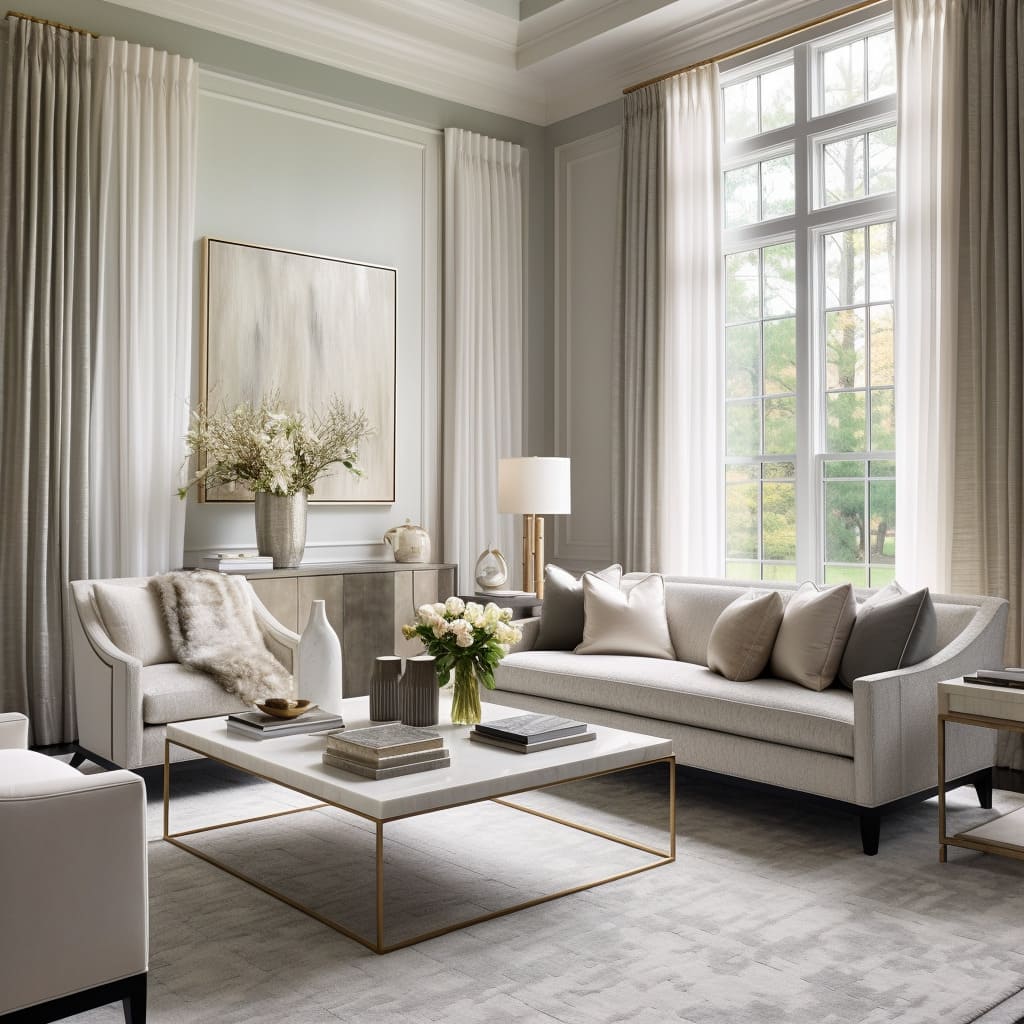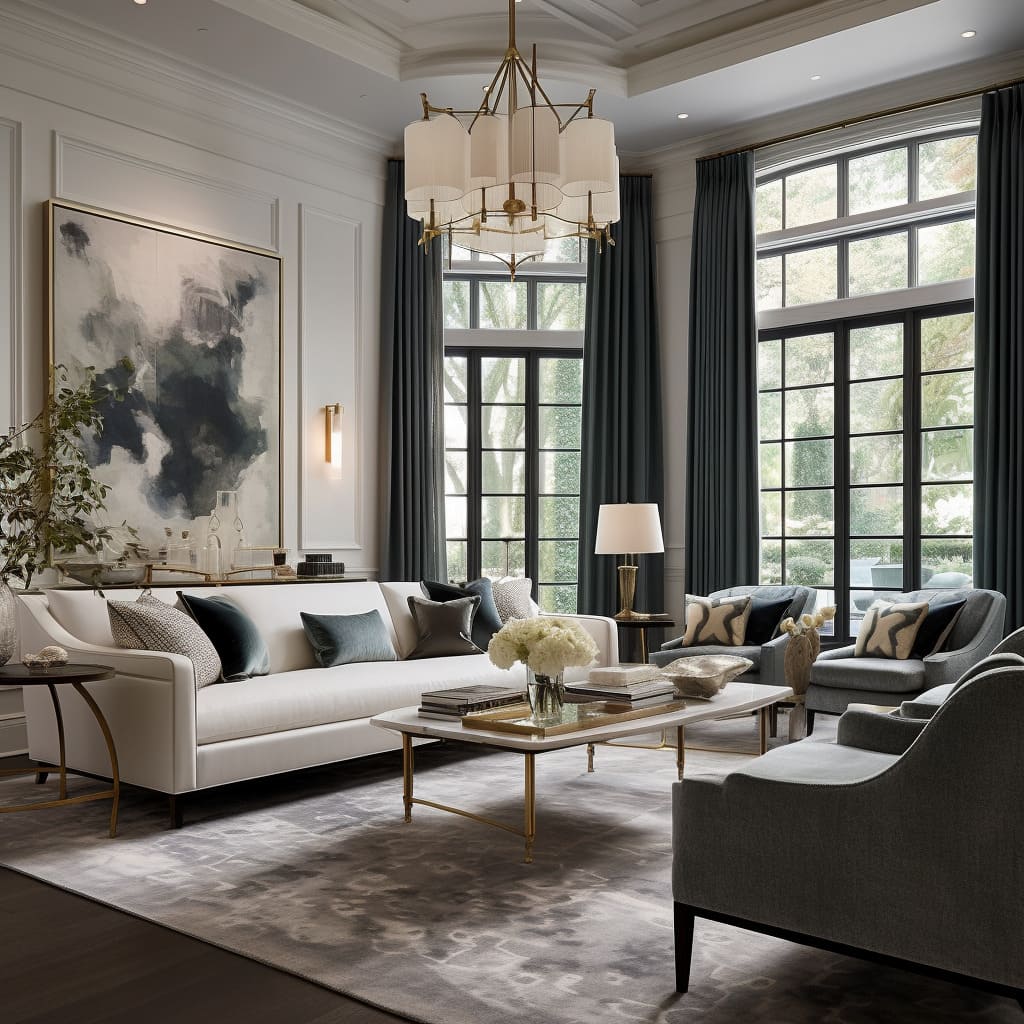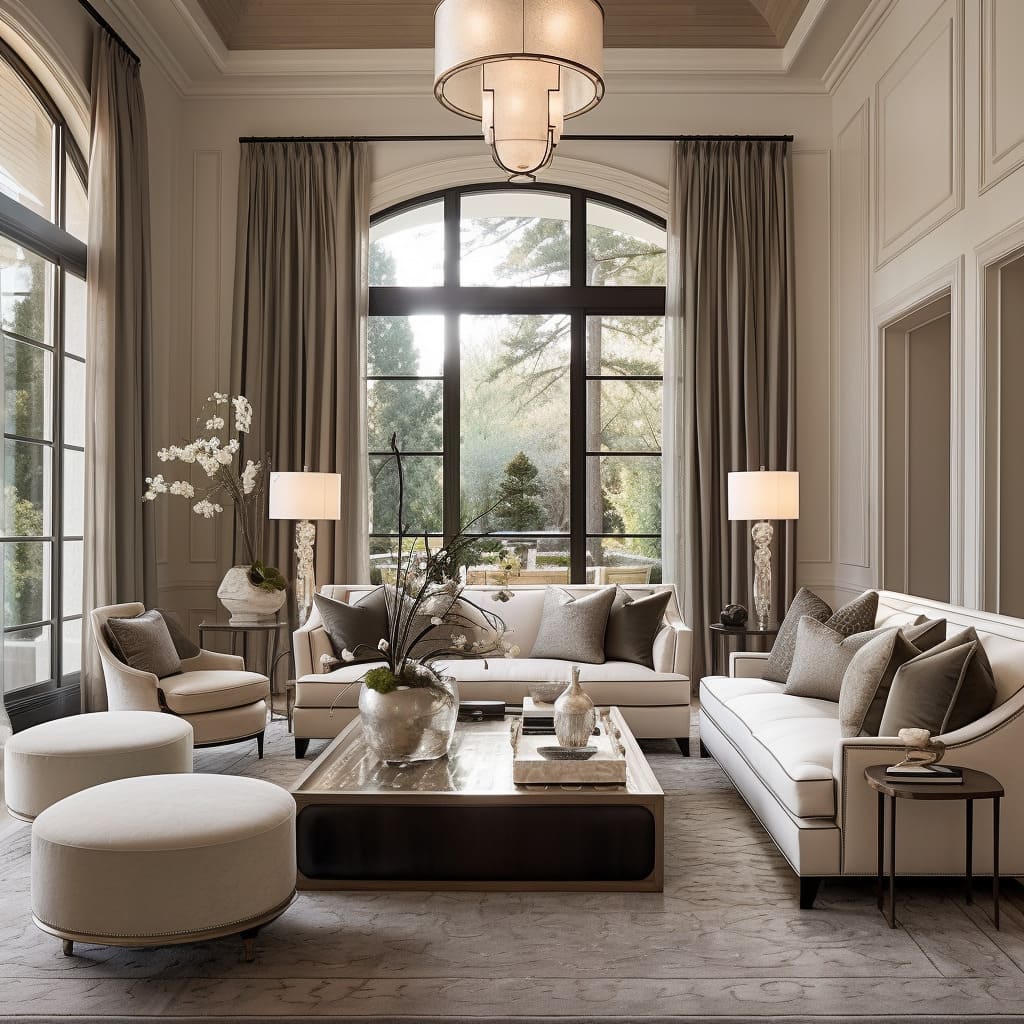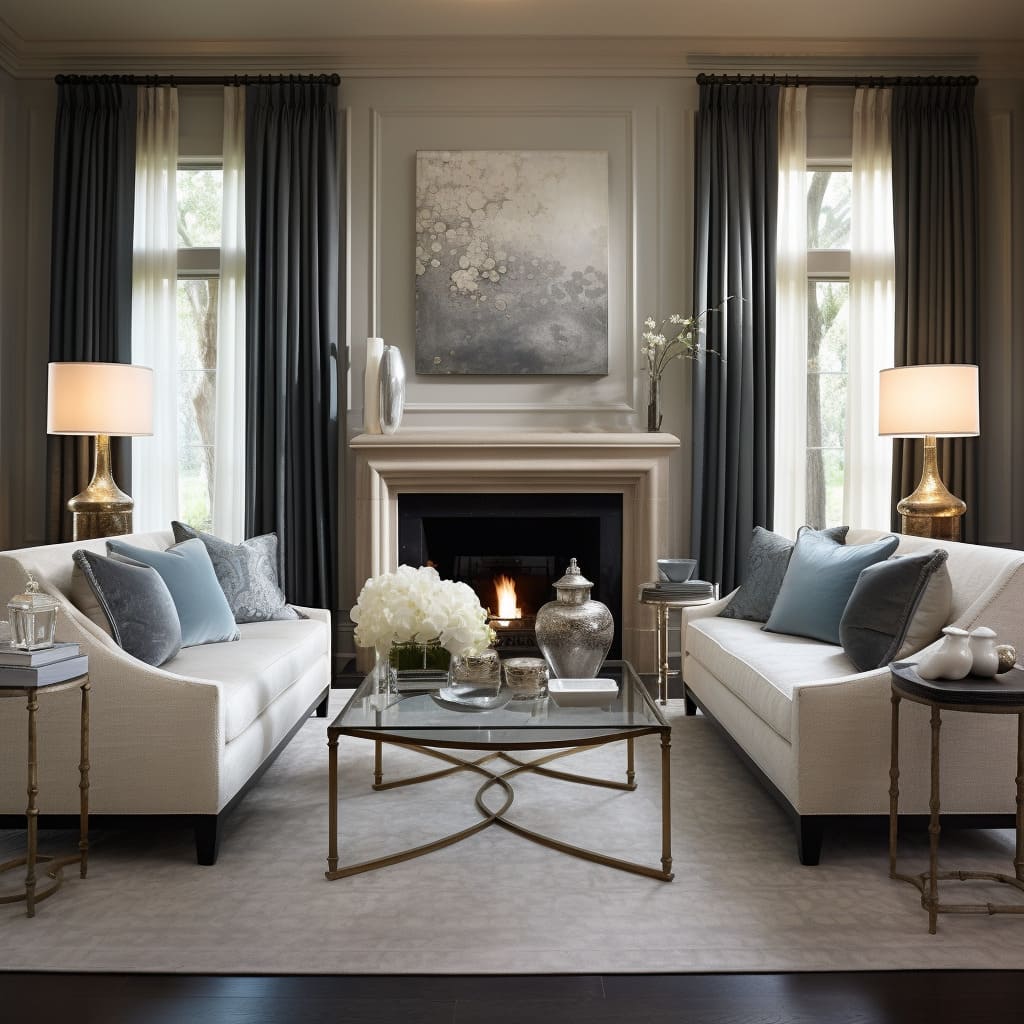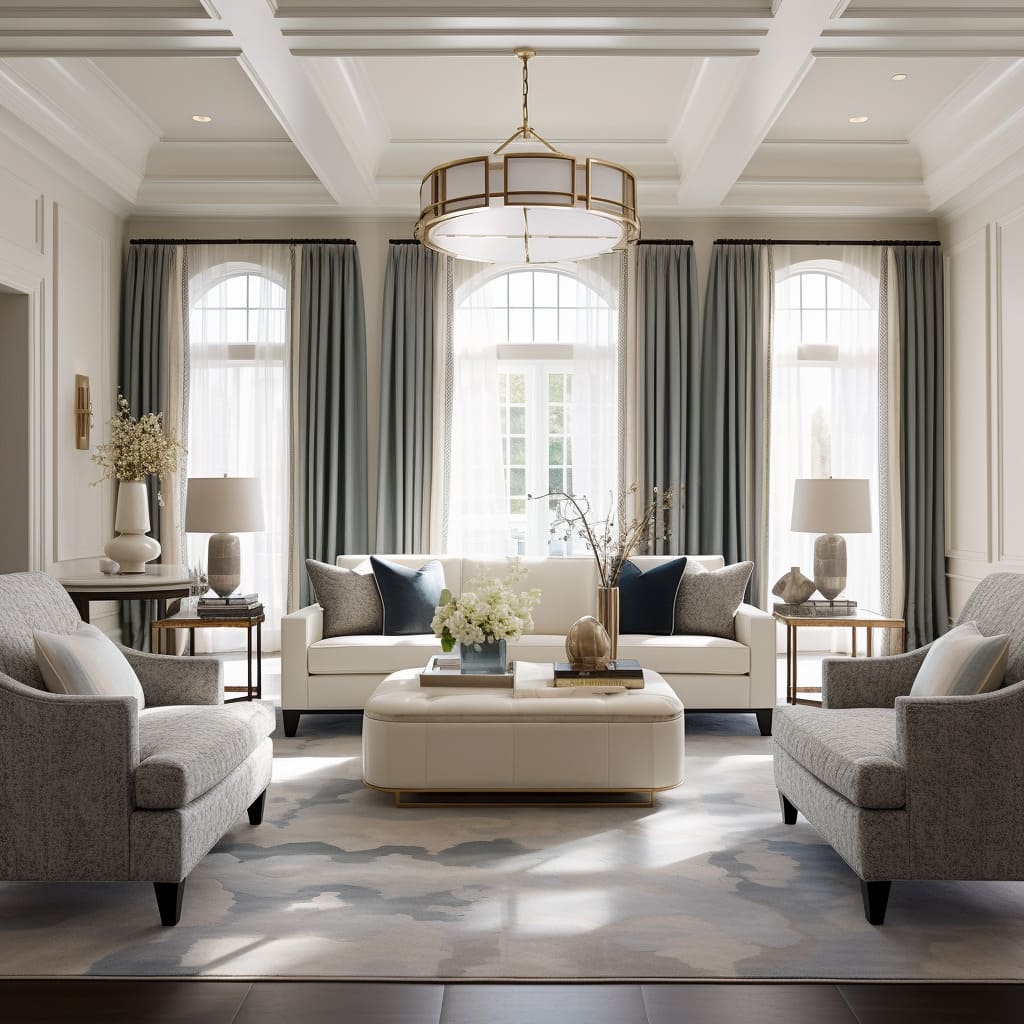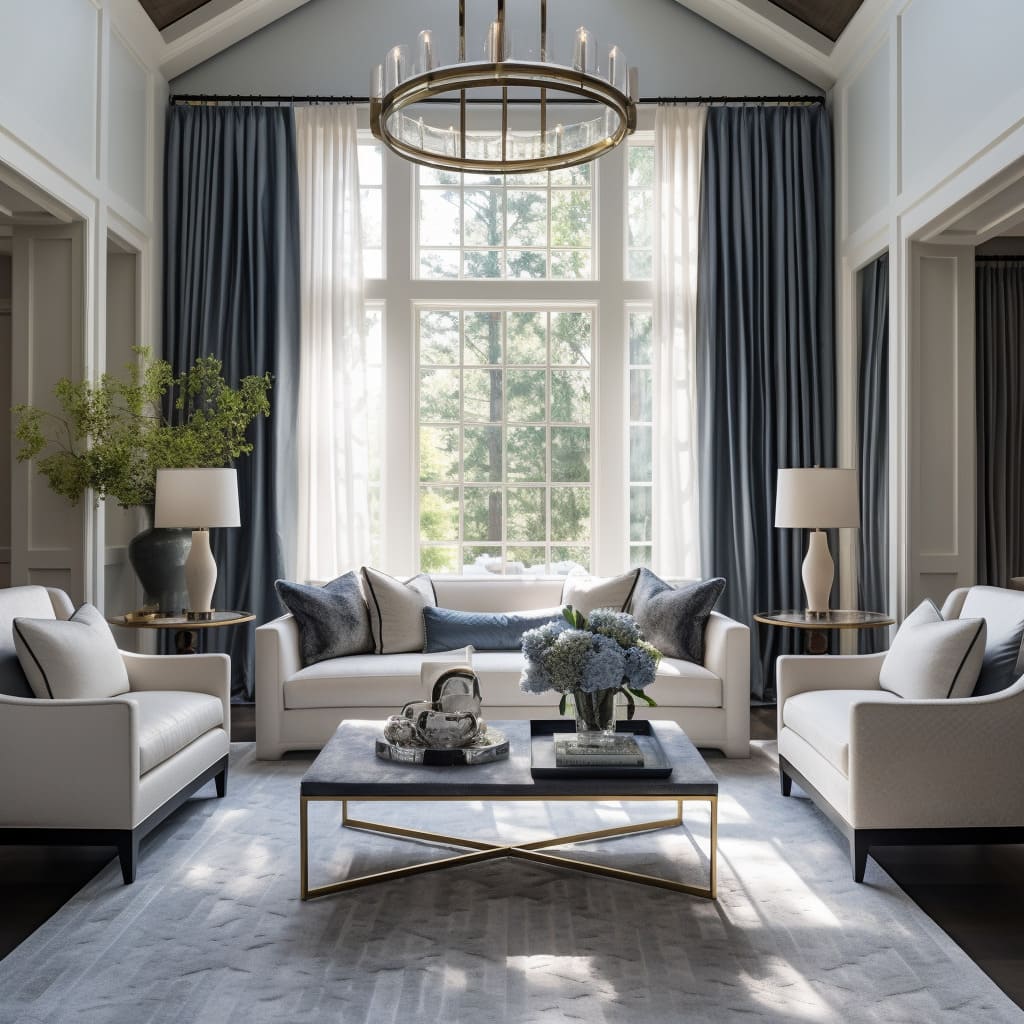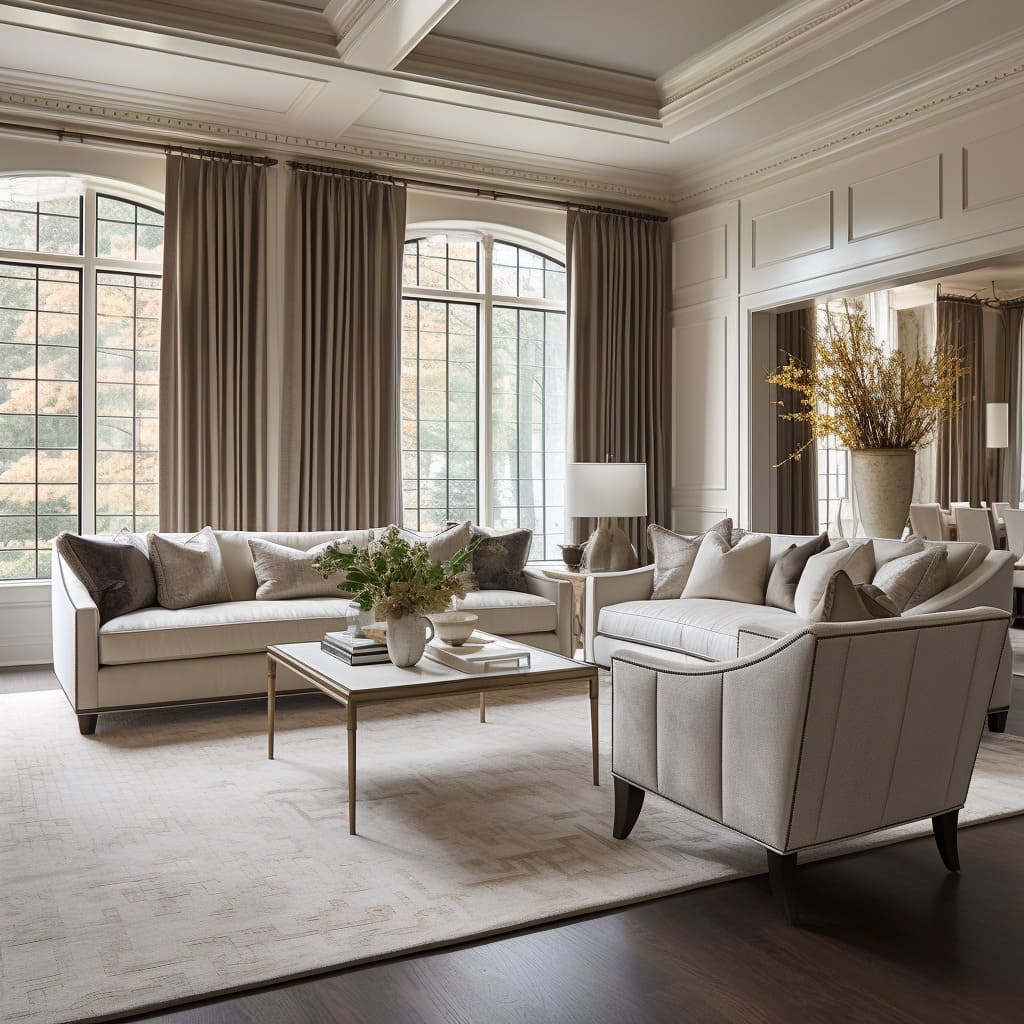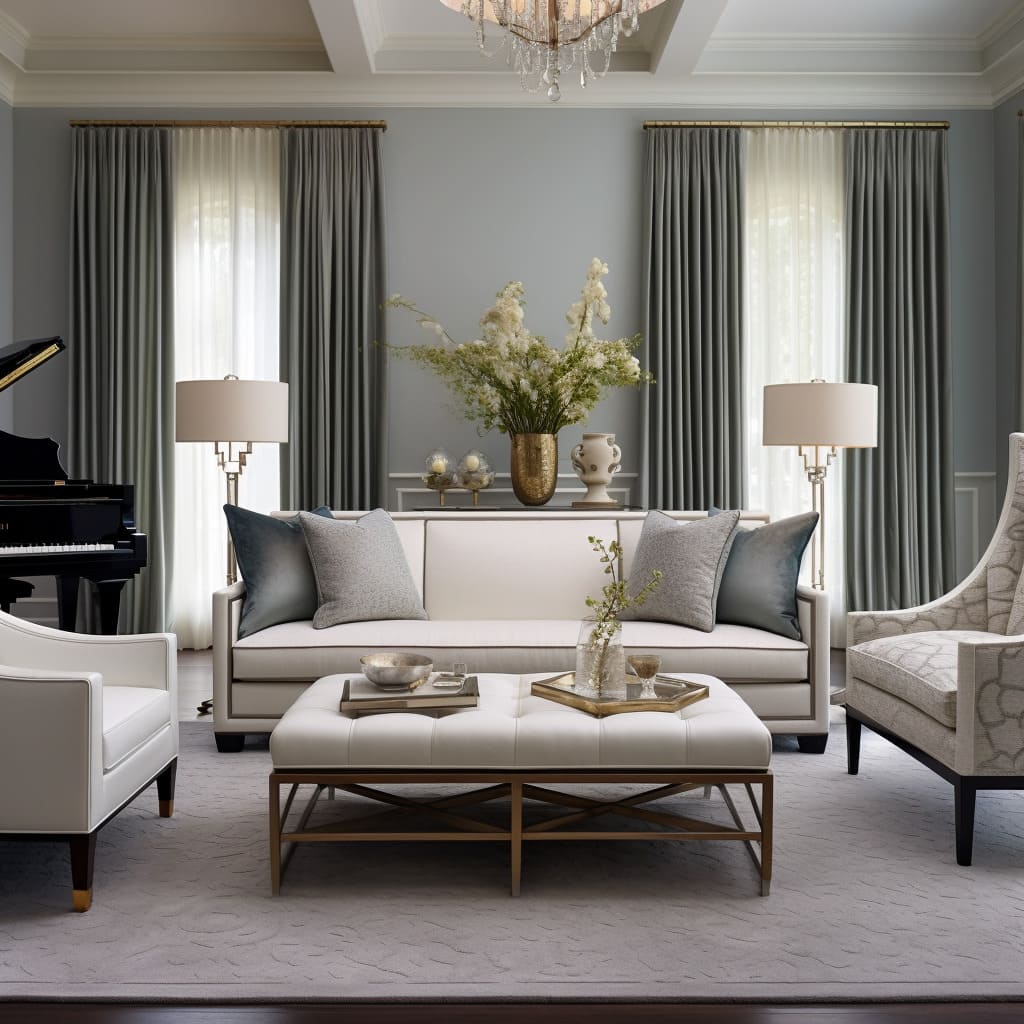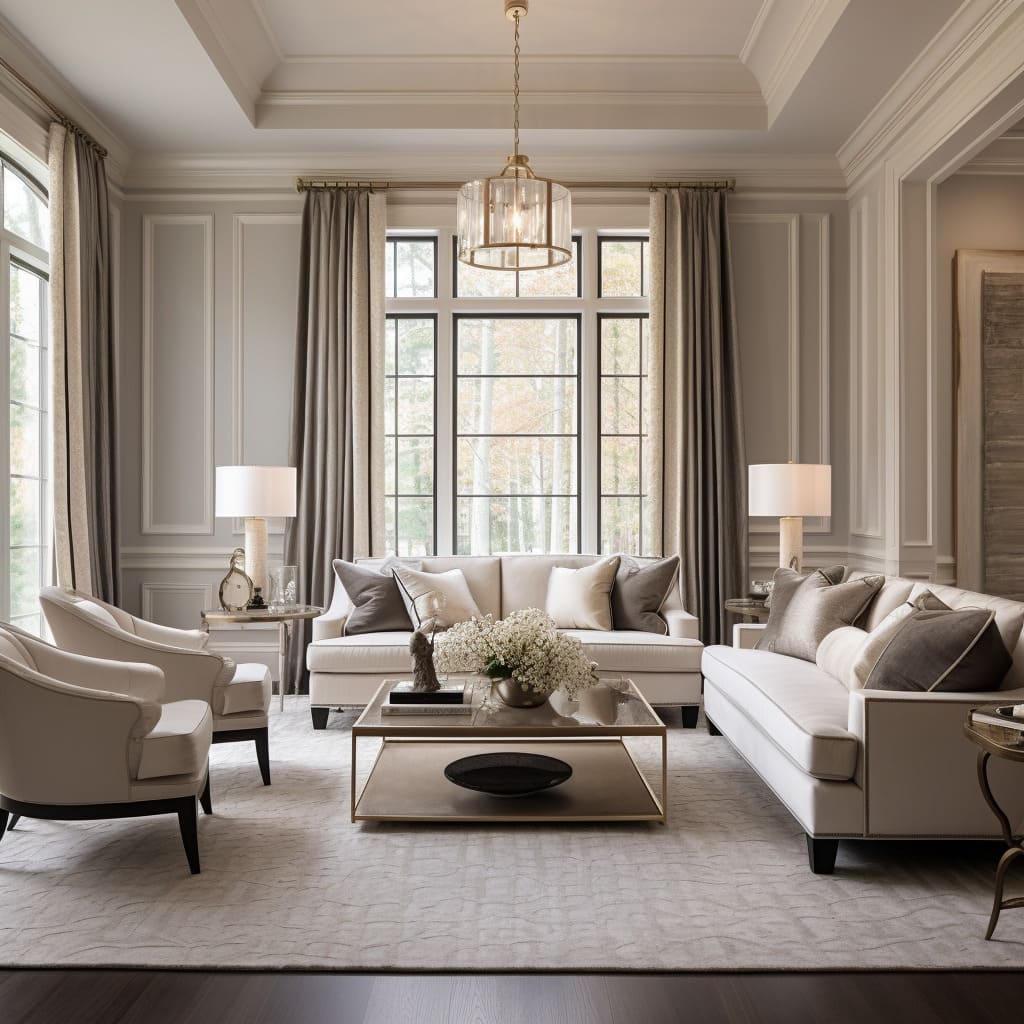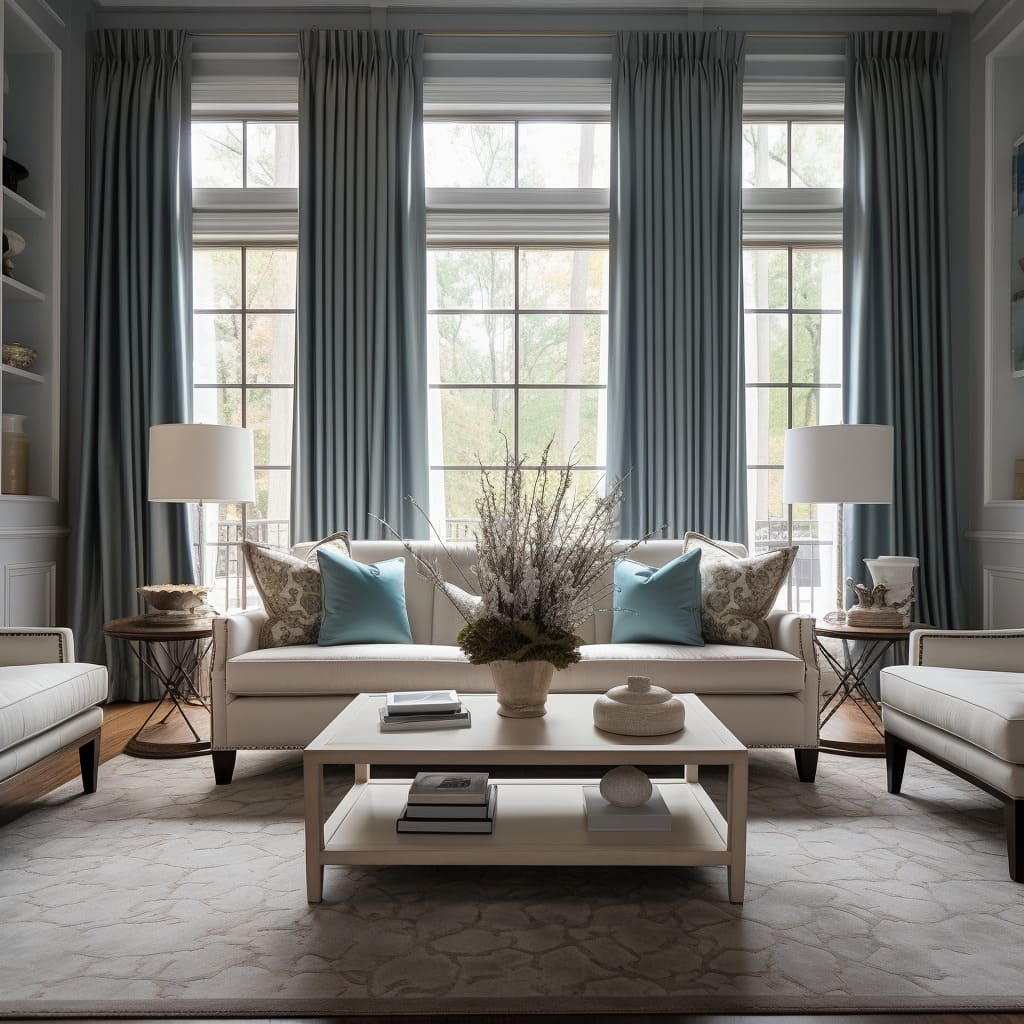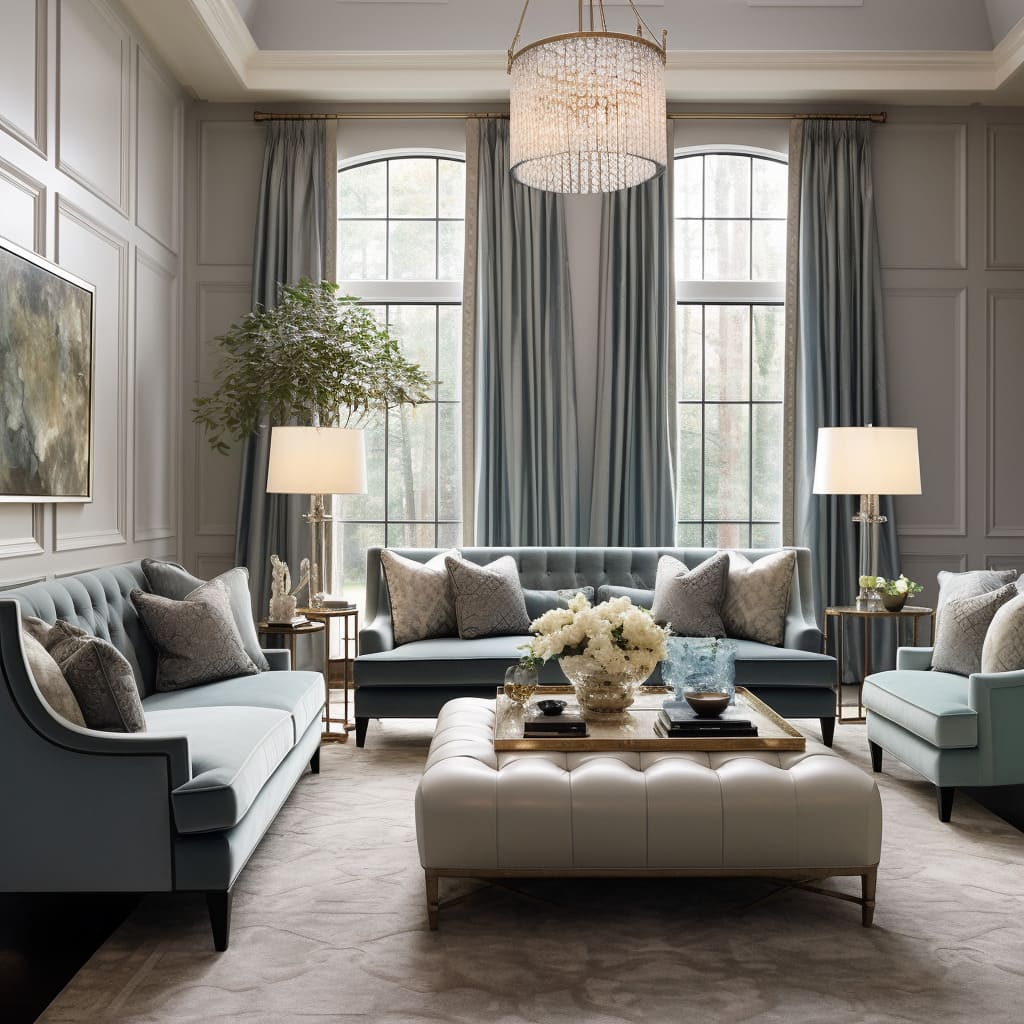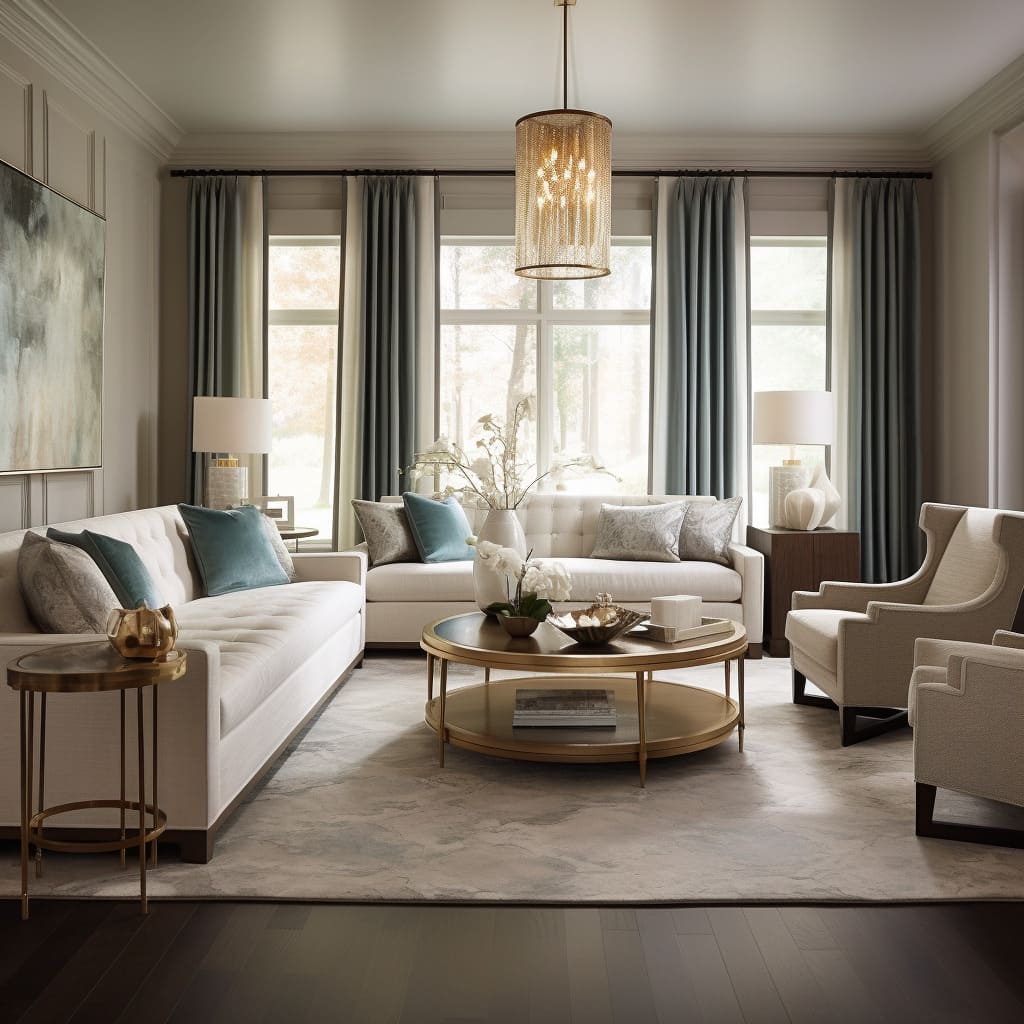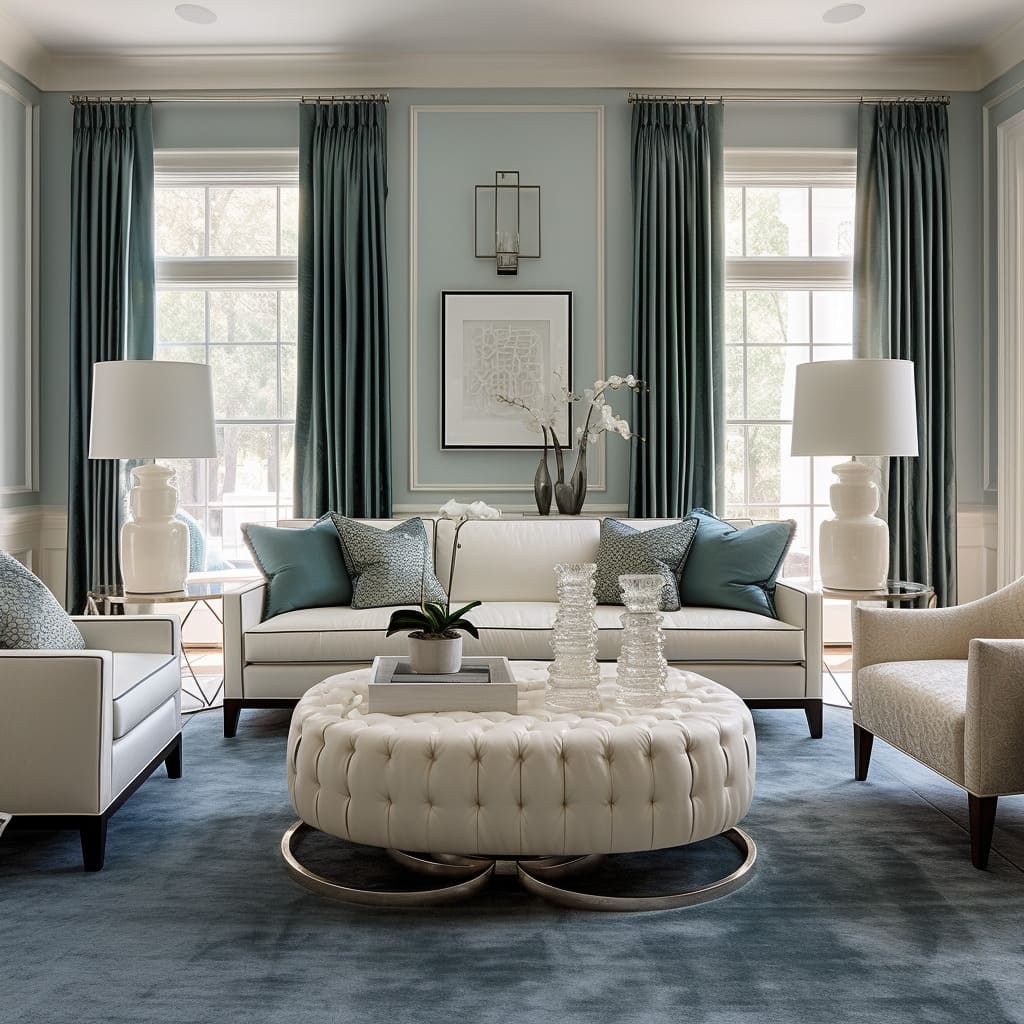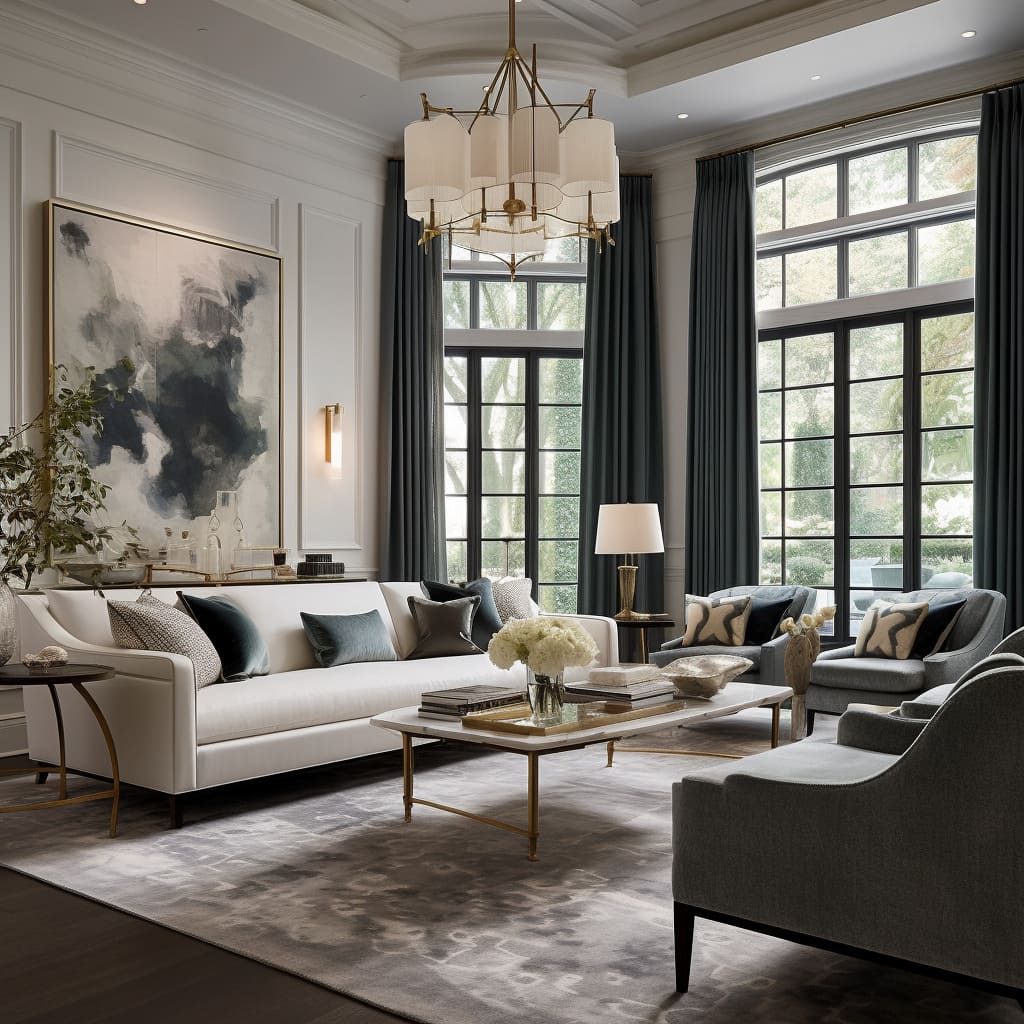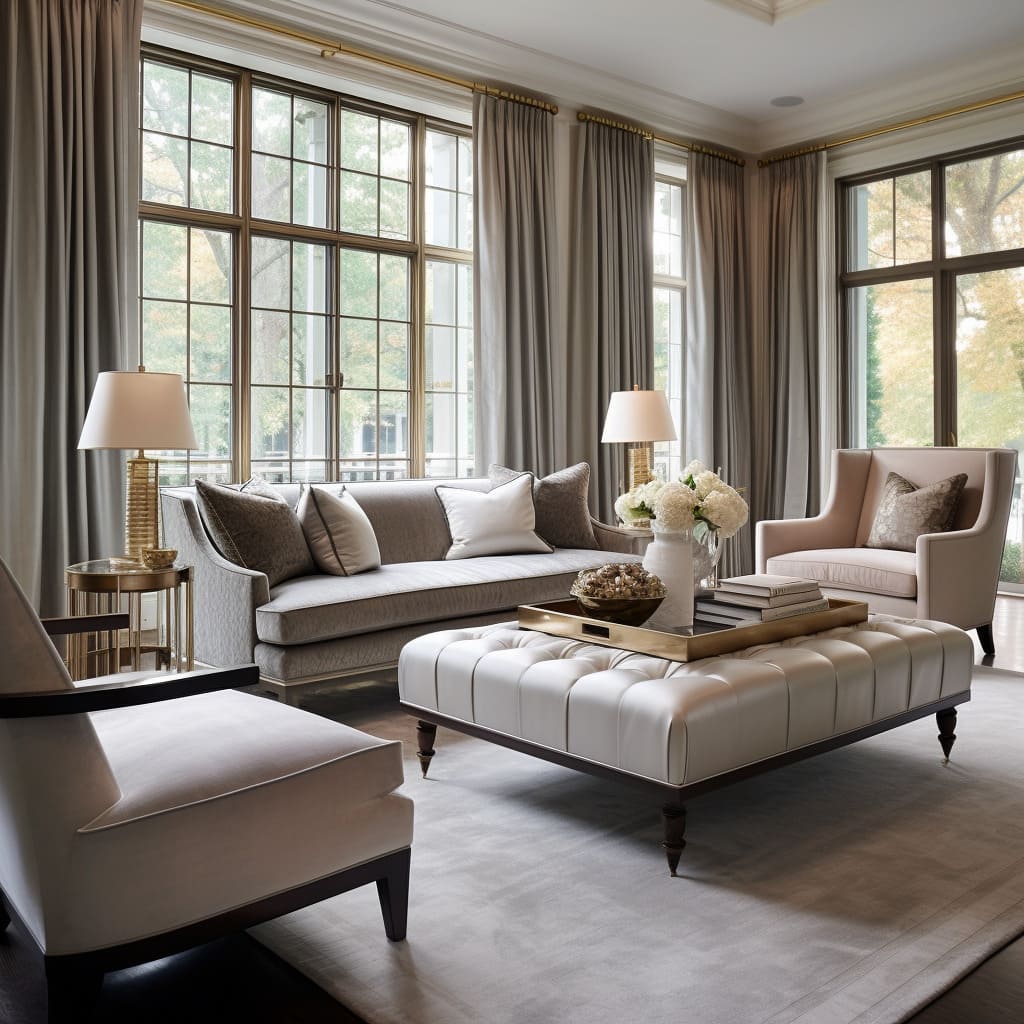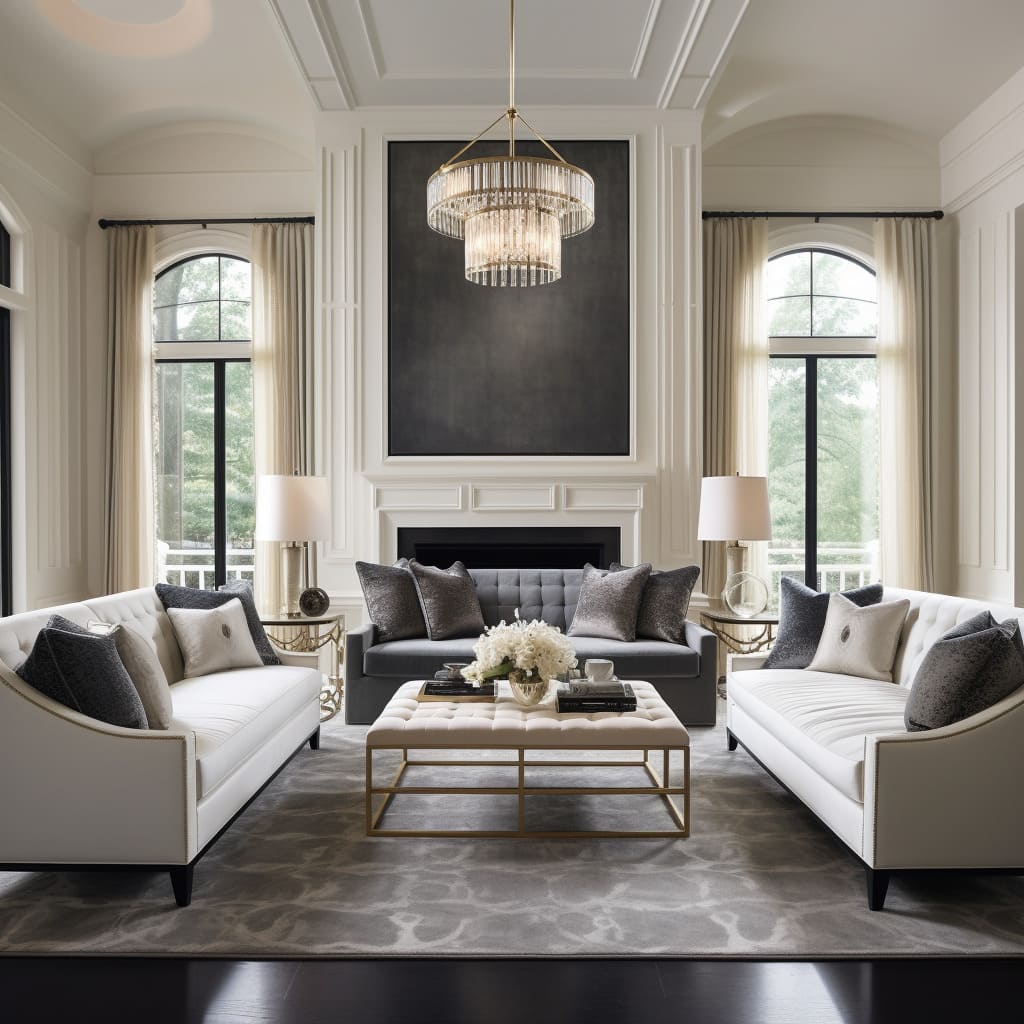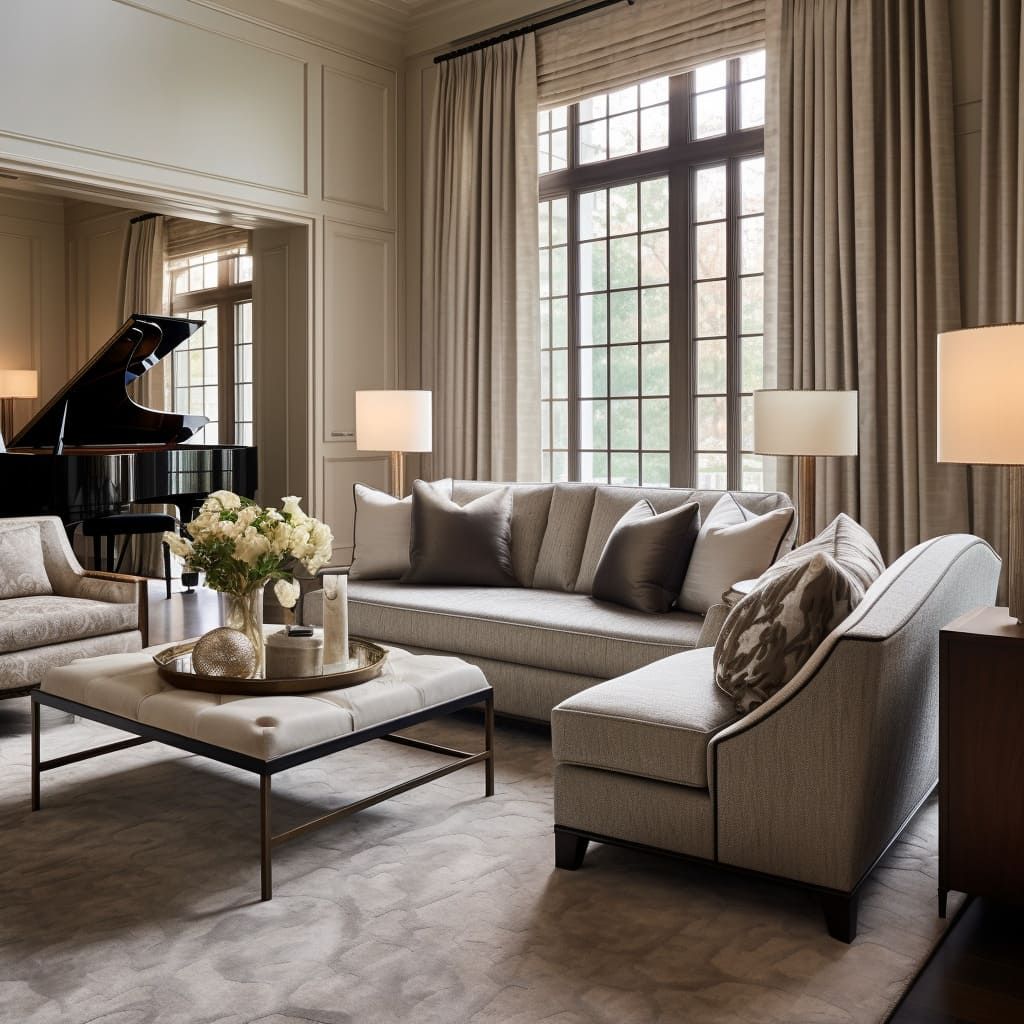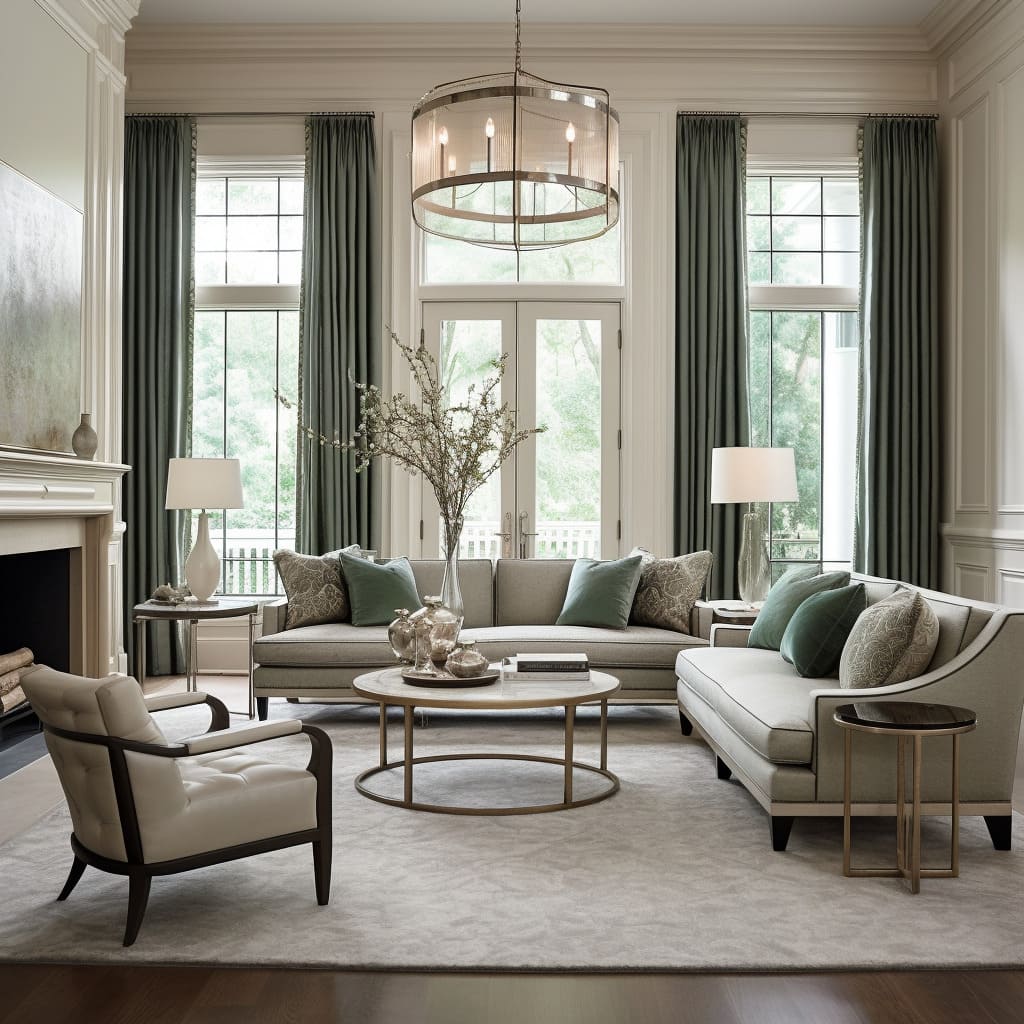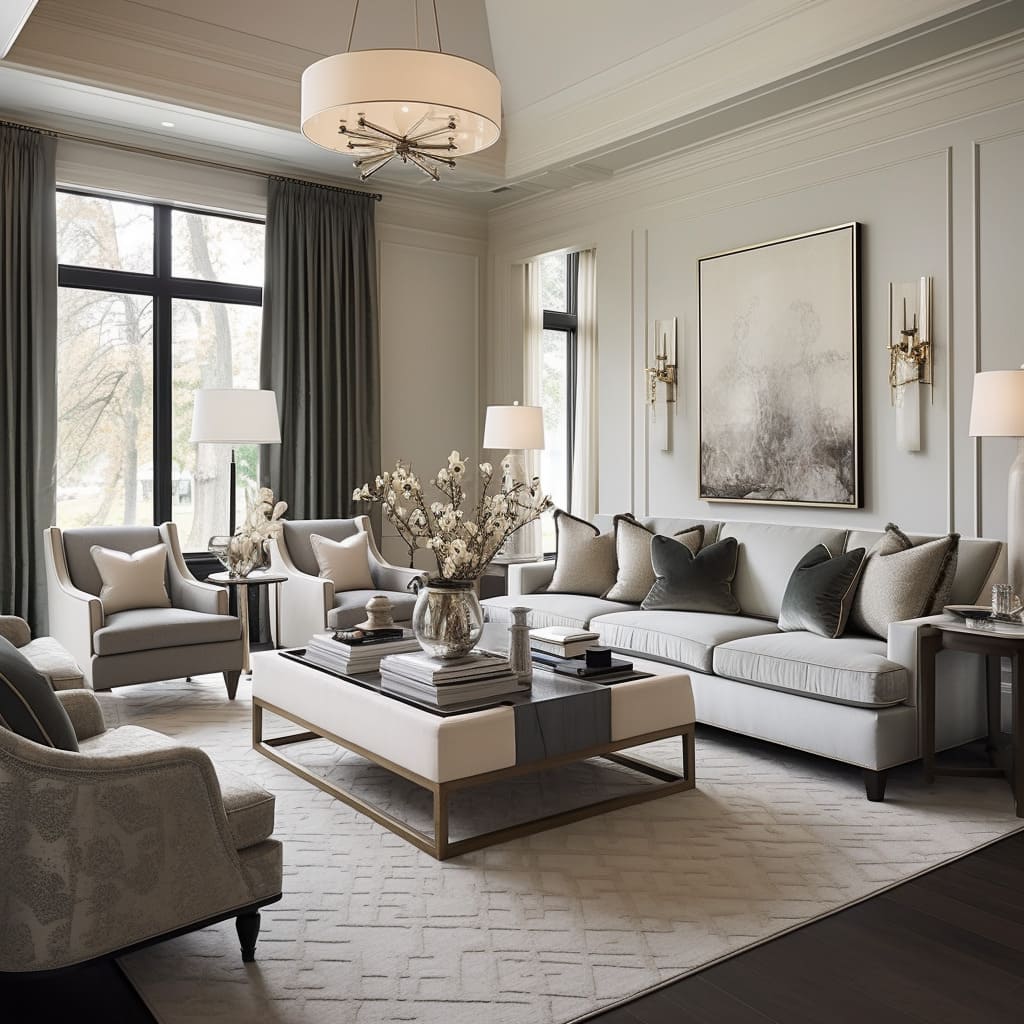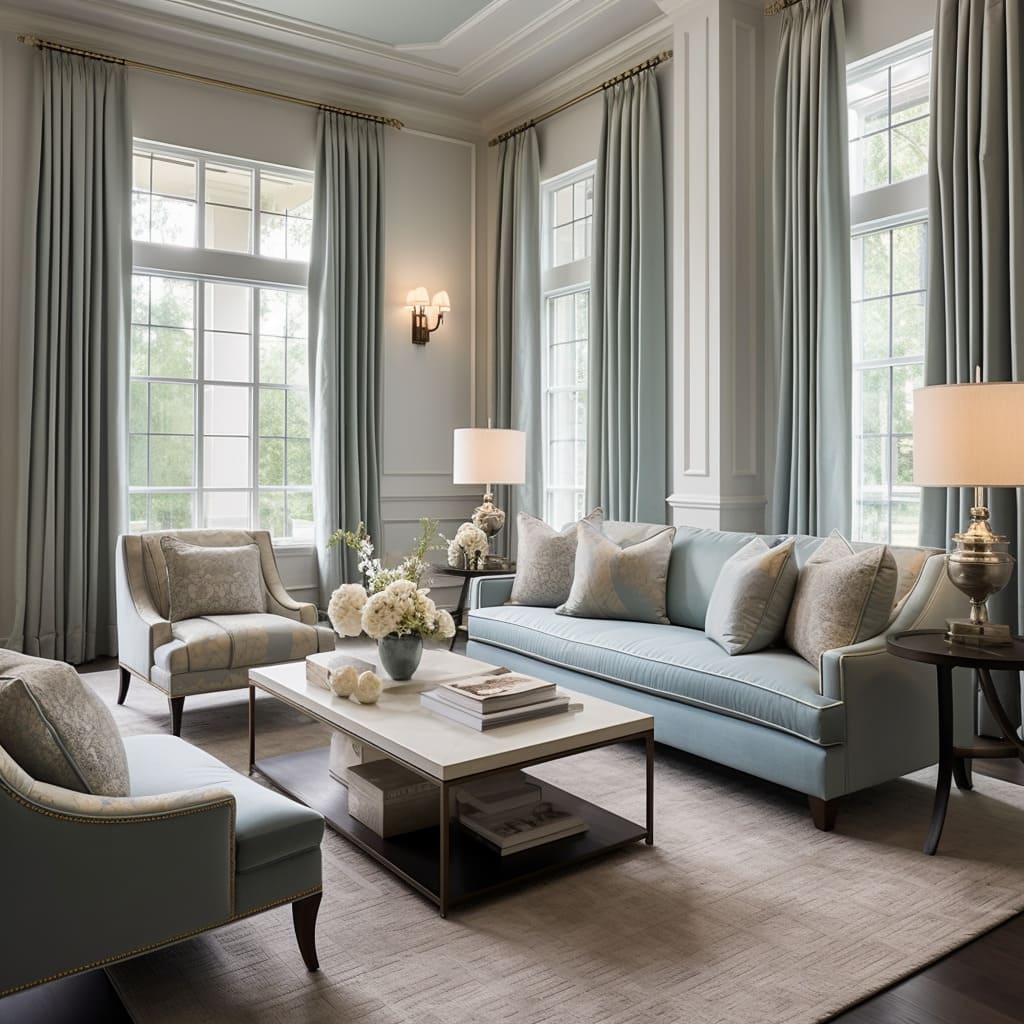With white walls as a canvas, the living room’s metal accents stand out as art pieces. This style melds the comfort and warmth of traditional design with the clean lines and understated color palette of contemporary style.
It features high-end materials, a neutral color scheme with strategic use of texture and color for depth, and a mix of classic and modern furniture pieces that together create a luxurious yet inviting space.
The transitional design is known for its timeless elegance and ability to blend the best of both old and new design philosophies.
Neutral Color Palette: Utilizes shades of whites, creams, grays, and taupes to create a serene and cohesive atmosphere.
Luxurious Textiles: High-quality fabrics in furniture and window treatments, often with a variety of textures to add depth.
Elegant Lighting: A mix of ambient lighting from table lamps and statement pieces like chandeliers, all contributing to the room’s warm glow.
Plush Seating: Comfortable yet stylish sofas and armchairs, often featuring plush cushions and soft upholstery.
Mixed Furniture Styles: Combines both traditional elements like tufted backs and modern lines for a timeless look.
Refined Metal Accents: Strategic use of metal finishes, especially in gold or brass tones, to add a touch of modernity and warmth.
Architectural Details: Attention to molding, paneling, and ceiling design to enhance the room’s grandeur.
The new classic design of the living room is a testament to timeless American decor.:
Harmonious Blend of Decor: Well-curated decorative items that complement the furniture and overall design theme.
Quality Woodwork: Use of high-quality wood in furniture pieces, contributing to the room’s elegance.
Statement Art Pieces: Carefully chosen artworks that serve as focal points and conversation starters, aligned with the room’s color scheme.
Layered Lighting: Incorporation of different lighting sources to create a dynamic and adaptable lighting scheme.
Symmetry and Balance: Furniture and decor are arranged to create a sense of order and symmetry, promoting calm and balance.
Accent Pillows: Use of throw pillows to introduce subtle pops of color and additional texture.
Area Rugs: Use of large, often patterned rugs to anchor the furniture arrangement and add a layer of comfort and luxury underfoot.
The Art of Textiles in Transitional Style Interiors
Textiles play a pivotal role in shaping the luxurious and harmonious ambiance of transitional style living rooms. The selection of fabrics is meticulously crafted, showcasing a sophisticated color palette and a diverse array of textures, each chosen for its complementary qualities.
In these interiors, sofas often feature high-quality, tufted fabric, lending a classic and elegant feel. The tufting adds depth and showcases traditional craftsmanship, while the neutral ivory hue acts as a unifying element.
Armchairs, in contrast, might be adorned with patterned fabrics, incorporating subtle floral motifs in soft colors like sage and pale blue, set against darker backgrounds. This blend of old-world charm and contemporary hues enriches the space without overpowering it.
Rugs in these rooms typically boast plush, abstract designs, harmonizing the room’s color scheme with tones of taupe, cream, and sage. They provide a warm and soft foundation that complements the dark wood flooring.
Luxurious, deep green velvet curtains often frame the windows, adding a dramatic touch with their rich texture and contrasting beautifully with the lighter walls. These curtains not only enhance the aesthetic but also offer practical benefits like insulation and sound absorption.
Accent pillows on the sofas and armchairs further play with the room’s color scheme, introducing a mix of solid colors and patterns in sage and pale blue tones. The variety of textures, from smooth to tactile weaves, adds depth and interest to the seating arrangement.
These thoughtfully chosen textiles, from the plush rugs to the velvet curtains and patterned armchairs, create a layered and luxurious feel. The careful matching of patterns and colors is subtle, allowing each piece to shine individually while contributing to the overall aesthetic.
The Interplay of Light and Elegance
In luxurious transitional living room designs, a key aspect is the harmonious combination of architectural finesse and refined textiles, which together cultivate an opulent ambiance. Central to this architectural elegance are the windows, integral elements that enhance the room’s grandeur.
These windows are typically expansive, with arched tops mirroring the room’s high ceilings, contributing to the space’s magnificence. They are often adorned with tailored drapery in muted gray, aligning with the room’s neutral color scheme.
This drapery is hung high, near the crown molding, accentuating the room’s verticality and drawing the eye upwards. The fabric’s sheen subtly catches and softens the incoming natural light, gently illuminating the space.
The windows themselves usually feature a classic grid pattern, adding a timeless charm and serving as a natural centerpiece. They not only invite the outdoors in but also establish a smooth transition to the external environment, often lush and tranquil, providing a striking contrast to the room’s polished interior.
The light filtering through these windows interacts with the room’s elements, like the textured fabrics of the furniture and the soft rug. This interplay highlights the various textures, from the plushness of the ottoman to the woven patterns of the sofa and armchairs.
The rug, typically sporting an abstract design in shades of gray and cream, adds a contemporary flair to the floor, unifying the room’s color theme. The ceiling, with its clean lines and recessed lighting, further enhances the room’s elegance.
A chandelier, often modern yet understated, acts as a central lighting feature, balancing the lighting scheme without detracting from the room’s overall aesthetics.
Bold Architecture Meets Delicate Textiles
Luxurious transitional living rooms artfully blend grand architectural features with meticulously chosen textiles, creating a serene and opulent environment. The flooring in such rooms is often rich, dark hardwood, providing depth and contrast to the lighter hues throughout the space.
This solid foundation anchors the furniture and is complemented by a lighter area rug, featuring a subtle pattern that adds interest without dominating the room.
The ceiling usually showcases classic architectural beauty, with crisp white crown molding that accentuates the room’s height and spaciousness.A central chandelier, often with a sleek metal framework and glass panels, serves as a modern counterpoint to the room’s classical elements. It casts a soft, ambient light, enhancing the room’s mood both during the day and in the evening.
Textiles in these living rooms balance plush and sleek textures. Sofas and armchairs are upholstered in high-quality fabrics, inviting relaxation and comfort.
Throw pillows in varying textures and colors, from deeper grays to creamy whites, integrate seamlessly with the overall color scheme.
These elements combine to create a sense of balance and harmony within the space. The architectural details offer a classic backdrop, while modern textiles and lighting add contemporary flair, making the room both current and inviting.
This approach to design results in a space that exudes a thoughtful, understated elegance, reflecting a meticulous attention to detail in every aspect.
Integrating Fireplaces in Transitional Designs
A fireplace can serve as a magnificent centerpiece, encapsulating the essence of the interior’s elegance. As a grand architectural feature, it anchors the space and draws immediate attention.
These fireplaces are often crafted with classic designs, featuring mantels in soft, neutral tones that contrast strikingly against the room’s darker walls.
Above the mantel, large, abstract paintings are common, introducing modern elements into the traditional setting. The artwork’s muted colors and organic shapes echo the room’s color scheme and add visual interest without overpowering the space.
The fireplace area is typically flanked by elegant, floor-to-ceiling windows draped in complementary gray curtains. These luxurious curtains add texture and depth to the walls, framing the windows beautifully and enhancing the room’s sense of symmetry and grandeur.
Flooring in such rooms is usually dark hardwood, offering a rich contrast to the lighter rugs and furnishings. This combination grounds the space and adds warmth.
The rugs, subtly patterned, complement rather than compete with the room’s textures and patterns, elevating the comfort and luxury of the space. Lighting is carefully curated, with table lamps featuring golden bases casting a warm, inviting glow that emphasizes the room’s cozy ambiance.
This soft light accentuates the textures of the textiles, creating depth and enhancing the fabrics’ richness. The furniture, upholstered in high-quality, neutral-toned fabrics, invites relaxation and harmonizes with the room’s elegant simplicity.
The blend of materials—from the softness of the sofa and chairs to the sleekness of the metal and glass coffee table—creates a balanced, sophisticated, yet welcoming space.
The fireplace stands as a focal point, embodying the design’s warmth, elegance, and balance. It synergizes with the windows, flooring, ceiling, textiles, and lighting to forge a cohesive, inviting living space that is both grand and intimate, reflecting the true spirit of transitional living room design.
The Role of Chandeliers
A striking feature is often the chandelier, a masterpiece that melds modernity with classic elegance. Commanding attention as it hangs from the ceiling’s center, this lighting fixture becomes a central focal point.
The chandelier’s size is proportionate to the room, filling the vertical space with a warm, inviting glow. Its intricate structure, reminiscent of a beaded curtain, combines numerous small pieces to form a globe-like shape, exuding the sophistication of fine jewelry.
The light sources within are cleverly obscured, allowing light to emanate through the gaps, casting a patterned illumination that adds depth and texture to the room. This lighting element does more than just illuminate; it harmonizes with other room features.
It complements grand architectural elements like the arch window, enhancing natural daylight and offering a soft, ambient glow in the evening.
The room’s neutral palette, from off-white curtains to variegated gray upholstery, is enriched by the chandelier’s golden light. The room’s textiles are luxurious yet understated.
Furniture is often adorned with high-quality woven fabrics, adding tactile richness to the visual experience.
The rug, plush and expansive, features a subtle pattern that supports rather than competes with the room’s focal points, reinforcing the elegant aesthetic. The chandelier is not just a lighting fixture but a pivotal element that encapsulates the room’s design philosophy.
It strikes a balance between luxury and comfort, enhancing the architectural beauty of the space and complementing the chosen textiles, resulting in a cohesive and sophisticated interior ambiance.
The Dual Role of Table Lamps
Table lamps play an essential dual role, augmenting the space both functionally and aesthetically. These lamps are not only practical sources of light but also key decorative elements.
Functionally, table lamps add a layer of ambient lighting that works in tandem with the natural light from large windows.
This is particularly important in creating a warm, inviting atmosphere during evenings or overcast days when natural light is limited. They provide necessary illumination, ensuring the room remains comfortable and usable at all times.
Aesthetically, the choice of table lamps extends beyond their lighting capabilities to their design and impact on the room’s decor. These lamps typically feature substantial and elegant bases, exuding luxury and a keen eye for detail.
The lampshades, often in neutral tones, blend seamlessly with the room’s color scheme, ensuring a harmonious integration into the overall design. Strategically positioned on side tables next to seating areas, these lamps enhance the room’s symmetry and balance.
They add height and become focal points within the decor, contributing to the room’s overall composition and appeal.
The soft glow emitted by the table lamps creates a cozy, intimate ambiance. This gentle lighting fosters a welcoming environment, drawing people into the seating areas for conversation and relaxation, further enhancing the room’s purpose as a social and comfortable space.
Table lamps in transitional living room interiors serve as much more than just light sources. They contribute significantly to the room’s elegance and cohesiveness, while their functional role ensures the space remains comfortable and inviting at all times of day.
The Allure of Metal: Incorporating Gold Tones
Metal finishes hold a significant place, adding a touch of opulence and modernity. These finishes, especially in gold tones, infuse warmth and luxury into the space, complementing the neutral color palette and soft textiles.
A prime example of this metal usage is the coffee table, where a gold-finished frame becomes a central design element. Its combination of sleek lines and elegant geometry makes a striking statement.
The reflective quality of the gold metal adds brightness and a sense of openness to the room, harmonizing beautifully with the glass top of the table.
The chandelier, another key piece, also features this gold metal finish. Its arms and structure, mirroring the gold tones found throughout the room, amplify the warmth of the space.
Beyond its functional role as a light source, the chandelier serves as a decorative focal point, elevating the room’s aesthetic.
Even in smaller details, the theme persists. Side tables incorporate gold metal finishes, creating a cohesive look with larger furnishings.
Table lamps with bases in a similar gold finish further tie these elements to the room’s overarching design. These strategic touches of metal draw the room together, enhancing the serene and plush atmosphere without dominating it.
Metal finishes in these designs are not just decorative but also functional, adding a layer of sophistication and playing with light to contribute to the room’s bright and airy feel. They strike a balance between utility and decoration, enhancing the space with their luxurious and refined presence.
In conclusion, the essence of luxurious transitional living room design lies in the meticulous blend of various elements that together create a space of elegance, comfort, and modern sophistication.
The harmonious interplay of textiles, from plush sofas to elegant curtains, sets a foundation of softness and luxury. Strategic use of lighting, be it through grand chandeliers or intimate table lamps, adds layers of warmth and ambiance.
The thoughtful incorporation of metal finishes, particularly in gold tones, introduces a touch of modern opulence that complements the neutral palette and enriches the overall aesthetic.
Key architectural features, like large windows and fireplaces, anchor the design, bringing in natural light and warmth, while the furniture and decor maintain a balance of traditional charm and contemporary finesse. Each piece, whether it’s a coffee table with a sleek gold frame or a rug with subtle patterning, is carefully chosen to contribute to the cohesive and inviting atmosphere.
This design approach results in a living room that is not only visually stunning but also a comfortable and welcoming space. It showcases how the right combination of elements can transform a room into a luxurious haven, perfect for relaxation and social gatherings.
Transitional living room design, with its blend of classic elegance and modern touches, ultimately creates a timeless space that resonates with both style and functionality.
The design of a transitional living room relies on the unity of the overall style and the selection of the right accessories. Unify the overall style tone, and add some design ingenuity, such as using some small areas of color decoration, such as custom patches, to increase the overall color.
For example, patches with unique patterns or textures can be added to sofas or armchairs. These patches can be in colors and patterns that echo the carpet or curtains, thereby enhancing the overall visual coherence. In addition, custom patches can also be applied to wall decorations, such as art tapestries or wall stickers. These patches can be designed with patterns that coordinate with the fireplace or large windows to further highlight the architectural features of the living room.

